#and its the very specific kind of christianity that exists here in the US
Explore tagged Tumblr posts
Text
I know I've been doing more mod posts than roleplay posts but christ aliveeee do you know how many expletives we use.in day to day life. "Oh my god," "Jesus Christ," "fuck," "what the hell," "goodness," "holy shit," or anything similar!!! All expletives are cultural, most of them involving religion or taboos. Fuck is a swear because sex is frowned upon, son of a bitch is a swear because having a child outside of wedlock is frowned upon, shit is a swear because excrement is viewed as gross, and don't even mention all the ones relating to Christianity! Anything "holy" is relating to God, saying Oh My Anything is essentially a prayer, "damn" refers to sending something to hell, even "oh, man" is a weird cultural thing that I don't know the meaning of but definitely stemmed from something specific. The only way I can get away with saying oh man is when I'm actually having Eve refer to Adam as man. Like "speak not to me of blasphemy, man!" sorta thing. They don't have the names Adam and Eve yet so it.works. the closest thing to an expletive I've used is when Adam refers to gods burning hand, "burning" being the expletive here because it hurt. But how do I use a swear when these people have never experienced any pain, and nothing is taboo? I'm kind of just having them groan and yell a lot
With the angels it's easier. They were created specifically to serve God, so anything outside of God is bad. The view everything in the context of The Lord™. They don't say things like "oh.my god" because that stems from praying, it's more like a quick plea, and angels don't pray. They do say things like "forsaken", to imply that God doesn't like that thing and therefore it sucks. It's used in a similar way to "damn," such as "I stubbed my toe on that forsaken coffee table" or "God forsake this mess!" The angel insults are wild too, they're not allowed to say anything that directly insults God, or imply that God is anything but Good, so I have to get creative. So they're saying things like "I fear God was distracted during the moment of your creation." It's very passive-aggressive, southern-baptisty. They say "God forsake" when they mean fuck as a verb. Like "God forsake you" instead of "fuck you." The angels of a higher rank are usually more aggressive with their insults because they know they're useful and they know that as long as they have no genuine bad feelings towards God, He doesn't care. The lower ranking ones (foot soldiers mostly) rarely ever insult anyone or imply anything remotely negative at all about God because they fear His wrath and they know they're expendable.
With the Fallen (angels, aka devils) it's not hard. They say things like "burning" and "bloody" and "blood and ash!" (Stole that from wheel of time) and pretty much anything to do with fire. For example, "Blood and ash! I stub my burning toe on this bloody coffee table, agh ow this flaming pious chunk of char!" Pious to show its stupid, because the fallen believe worship of any kind is stupid, and they don't like god very much. Chunk of char/charcoal to show that it's functionally useless and serves no purpose and is a waste. The angels and the Fallen existed before the humans did so.they had time to create some semblance of culture.
I wonder what the watchers will do. I mean they were stationed on mt ararat for thousands of years they're gonna be speaking practically a different language. With all the inside jokes and the shared duty/purpose.. it's gonna be really specific. I'll probably have the ability to pay attention be a good thing, and distraction be a bad thing. Like "shit semjaza are you distracted?" At first it was an actual insult but then they realized they were literally doing nothing and they didn't need to pay attention anyway so it kinda became a joke. Still, things relating to attention/distraction are used as expletives left over from a time when it actually mattered. Like saying "punished again by inattention! I stubbed my toe on this coffee table!" Other swears will be specific to the one speaking. A blacksmith might say "this warped coffee table," a jeweler might call it impure or inclusive, an astronomer might call it cloudy.
Basically in order to determine what to use for swears I have to determine the values of the group, what they like and their taboos, and incorporate that in a way that doesn't sound silly. I'm writing this in a way where they speak an ancient language and I'm translating, so if they were speaking their hypothetical native language it would be normal, but this is English which is so heavily influenced by Christianity that anything besides that sounds stupid! Aghgh I hate globalization
Anyways thank you for coming to my ted talk. Can u tell I like anthropology
#adam and eve#the book of genesis#religion#linguistics#fanfic#fanfiction#writing#mod post#out of character.#Christianity
28 notes
·
View notes
Text
I just read Unwelcome Ozian's "Rules of Programming," and Oh Boy.
For those who don't know, Unwelcome Ozian is a conspiracy theorist on Tumblr who purports himself as a kind of guide for people who believe themselves to be programmed multiples - that is, people with deliberately-induced dissociative identity disorder, with alters carefully programmed for specific purposes by means of brutal torture methods. His claims are largely based on the work of Fritz Springmeier and Cisco Wheeler, two far-right conspiracy theorists who spun this whole mythology about an ancient satanic cult that uses torture to put people under what they referred to as "trauma-based mind control," or TBMC. (They also claimed that the fight for gay rights was part of the plan to enthrone the Antichrist in the year 2000, and that Al Gore carried around a briefcase full of blood to drink. That's the level of credibility they're on.)
There have also been a number of abuse allegations (including allegations of sexual abuse) against Unwelcome Ozian from those who came to him for help, so yeah. Also, he really hates Svali (another conspiracy theorist working from Springmeier and Wheeler's mythos) for some reason.
Rules of Programming effectively distills a lot of the stuff you find in the works of Springmeier and Wheeler, with the addition of some actual scholarly concepts/research plus some pop-psychology/pop-self help style lists of things programmers supposedly do to their victims. (A lot of the things it talks about are just regular forms of authoritarian abuse, gaslighting, scapegoating, etc. In fact, some of them even appear to be copied from Internet articles.)
Essentially, this book is yet another modern witch finder's manual, giving anyone who wants to find diabolical witches a set of unfalsifiable criteria that will always appear to confirm their presence. Like the work of Springmeier and Wheeler, its descriptions of torture are just evocative enough to play on the imaginations of people who may not be in the best mental shape and fuel the creation of confabulated memories. (Some of which may very well be mingling with memories of real abuse.)
Oh, and just to be clear, we do have very clear cases of confabulated memories - you can see them for yourself here and here. If you don't want to click the links, the tl;dr is that the New Age movement is chock full of people who very vividly "remember" past lives in pseudohistorical settings and locations that never existed, and some of these "memories" are quite vivid and disturbing.
So, here's some notable stuff from this book:
Marijuana is supposedly contraindicated for programming purposes. (This claim was made by Springmeier and Wheeler in How The Illuminati Creates A Total Undetectable Mind Controlled Slave, but it goes back to Cathy O'Brien and Mark Philips.)
Victims are allegedly given types of programming such as heart of stone programming and color, gem, and flower programming. (These were first described by Springmeier and Wheeler in They Know Not What They Do: Illustrated Guide To Illuminati Mind Control, which was published in 1995.)
Handlers must allegedly present themselves as omnipotent and god-like to victims. But they may also manipulate their victims by threatening suicide. (These two things really don't go together, especially if the cult as hardass as it's claimed to be.)
Alleged behavior of programmers - "Teach children self-betrayal, i.e. show gratitude and humility for punishments and insults." This is literally just how authoritarian Christian parents expect you to behave when punished. (Again, most of the things programmers supposedly do are just things that regular abusers do, period.)
He talks about practices such as anchoring and future pacing, which are described by Springmeier and Wheeler in How The Illuminati Create A Total Undetectable Mind Controlled Slave (published 1996).
Direct quote, "For example if a programmer builds a system using the planets of the solar system there will be alters with planet names, and space terminology used." Compare with "In recent years, these have been solar systems, galaxies, and planets, because they have gone to Star Trek, Star Wars, Alien types of programming" from How The Illuminati Create A Total Undetectable Mind Controlled Slave. Again, it's the same mythology.
He claims epsilon programming is used to create animal alters and describes how they're allegedly created. The stuff he describes can be found in How The Illuminati Create A Total Undetectable Mind Controlled Slave.
He lists off a bunch of stuff that's supposedly trauma-based mind control spiritual abuse. In reality, it's just regular spiritual abuse - for example, "the programmer/handler is in a ‘divine’ position," "misuse of scripture to control behaviour," and "appeal to the work of evil spirits as explanations for the child’s behaviour."
About that last one? A very similar line appears in the article Part 2: The characteristics of spiritual abuse: "Appeal to the work of evil spirits as explanations for the victim’s accusations or behaviour." The earliest archived version of this page is from 2017. The Rules of Programming was published in May of 2023.
The book's text on cultivating a trauma bond includes several items that appear to be slightly reworded text from Dr. Joseph M Carver's article Love and Stockholm Syndrome: The Mystery of Loving an Abuser (first archived on the Wayback Machine in 2015). For example, "The presence of a perceived small kindness from the handler to the child" (RoP)/"The presence of a perceived small kindness from the abuser to the victim" (Carver).
The book's text "Seeking/finding pleasure in the presence of extreme danger, violence, risk or shame" is also found in the article Impact on Abused Persons, which cites a 1997 book, The Betrayal Bond: Breaking Free of Exploitive Relationships.
A bunch of stuff associated with toxic relationships are rephrased as stuff associated with being a victim of TBMC.
The book claims that some "programmed responses" might be "They are only like that because they love me," "You wouldn’t understand," "They will make it up to me later," and "It’s my fault, I make them angry." This text can be found in the 2021 article, The Misconception of Trauma Bonding.
The book lists some benefits of playing chess (for example, "Playing chess can improve cognitive skills like memory, planning, and problem-solving") that appear verbatim in the Healthline article The 9 Best Benefits of Playing Chess.
Some text (for example, "Trauma can shut down episodic memory and fragment the sequence of events") appears to have been copied from the 2017 infographic, How Trauma Impacts Four Different Types of Memory.
Material from changingminds.org appears to have been copied into this book. For example, the text "Agreement over rules typically starts with generalised rules with which it is hard to disagree" can also be found on the page titled Confession, with the slight difference that "generalised" is spelled with a Z. (Its earliest archived version dates to 2004.)
The book claims, "Torture involving states of extreme pain and terror, to the point of near-death, is required to install programming." This inadvertently reveals the absurdity of the alter programming conspiracy theory, because in the real world millions of abusers and cult leaders manipulate and control people with far less dramatic methods every day. Even if alter programming was a real thing, it would be so pointlessly overcomplicated that you'd have to ask yourself why so many people would bother with it.
The book describes a number of abuses and tortures that pretty obviously stem back to European witch panic, including "desecration of Judeo-Christian beliefs and forms of worship," taboo sex, ritual cannibalism, and dedication to Satan.
The book includes the "Steps on Obedience," which are found in Svali's older writings. Additionally, some of the text seems to be copied from Svali's old writing with minor modification. For example, The Rules of Programming says, "The part/alter is placed in a room without any sensory stimulus. The room will have grey, white, or beige walls. The programmer leaves the part/alter alone for specified lengths of time: these times may vary from hours (2-3) (3-5), to days as the child grows older." Compare with Svali: "The small toddler/child is placed in a room without any sensory stimulus, usually a training room with gray, white, or beige walls. The adult leaves and the child is left alone, for periods of time: these may vary from hours, to an entire day as the child grows older."
The book gives a list of supposed secret meanings to perfectly normal hand gestures, which is very obviously sourced from How The Illuminati Create A Total Undetectable Mind Controlled Slave. (RoP: "Hands locked folded interwoven backward - - you can’t break “the circle”". HTICATUMS: "Hands locked folded interwoven backward--you can’t break "the circle"")
The book claims that programmers will write down detailed documentation after each programming session, describing exactly how the session went and what should be done at the next session. Additionally, block reports are supposedly written every four weeks, which summarize the whole thing. This is noteworthy because if this conspiracy theory was actually true, this type of documentation would have come to light at some point by now. The fact that is has never turned up in all of the years alter programming has allegedly been practiced (since the mid-20th century or since ancient times, depending on who you ask) is incredibly damning.
(Break here because this list is reaching Tumblr's text block limit.)
Some text (for example, "A Place in the World. One never need 'find' his or her place because in fact that type of autonomy is not allowed! There is often a false egalitarianism which disguises competition" and "Mystical Manipulation. False origin stories or very selective accounts are given about the leader to demonstrate divine authority, spiritual advancement") seems to have been copied from the article Communal Abuse and Cults (earliest archived version: 2017).
Some text (for example, "Change Of Diet: Creating disorientation and increased susceptibility to emotional arousal by depriving the nervous system of necessary nutrients through the use of special diets and/or fasting" and "Hypnosis: Inducing a high state of suggestibility, often thinly disguised as relaxation or meditation") seems to have been copied from Brainwashing & Mind Control Techniques (earliest archived version: 2004).
Some text (for example, "Sins, as defined by the leader, are confessed either to a personal monitor or publicly to the group" and "Sacred Science: The group's doctrine or ideology is considered to be the ultimate truth, beyond all questioning or dispute") appear to be sourced from Robert Jay Lifton's eight criteria of thought reform. (Originally written in 1989.)
The text "Crafty redefinition of existing words (and the definition of new ones) to powerful euphemisms, secret codes, renamings, buzzwords, chants and mantras, ‘speaking in tongues,’ forced silence, even hashtags" may have been sourced from Cultish’s Exploration of Manipulative Language (originally posted in 2021), or from Amanda Montell's book, Cultish: The Language of Fanaticism.
Some text (for example, "The group devoutly believes it will be the ultimate winner of the final battle" and "Lack Of Restraint: Leaders believe themselves to be free from religious and social laws") appears to have been sourced from Doomsday Religious Movements - Canadian Security Intelligence Report (dated December 18, 1999).
The text "Glittering Generalities: These are intense, emotionally appealing words so closely associated with highly valued concepts and beliefs that the appeals are convincing without being supported by fact or reason. The appeals are directed toward such emotions as love of country and home, and desire for peace, freedom, glory, and honour" appears to come from Wikipedia.
"Name-calling: Name-calling seeks to arouse prejudices in an audience" also seems to be derived from Wikipedia.
The book mentions "Being locked in a small confined spot, a pit or cage with spiders and snakes" as a form of torture. This one can be traced back to Michelle Remembers.
The text describing bladder torture in RoP is identical to the text describing it in How The Illuminati Create A Total Undetectable Mind Controlled Slave. I'm not going to post it because it's kinda graphic, but feel free to compare the texts yourself. Just search for the text "urinary bladder."
Basically, most of the alleged tortures and programming methods are very obviously sourced from Springmeier and Wheeler's books, even if they aren't always described with identical text.
A list of tortures in the book include the hell confinement, the Tucker telepohone, the strappado, the Cold Cell, the German Chair, the box, white torture, and the Tiger Bench. Most of these can be found on this Listverse article from 2013, and RoP's descriptions match up with Listverse's.
So basically, we have someone claiming to be a trauma-based mind control survivor, but a lot of his information very obviously comes from other sources. (Now just to be clear - it's not possible to tell whether any of the copied text comes from the actual webpages I linked, or if they were sourced from other pages or books with the same text. But either way, it's obvious he didn't come up with all this stuff on his own.)
I also think the fact that this book includes so many descriptions of actual abusive behaviors and practices makes it all the more insidious. The author effectively links a lot of stuff that actually does happen with the conspiracy theory in such a way that it can all look like it's the exact same thing, making it seem like if you suffered from these real types of abuses, then you may have likely been a victim of alter programming.
But here's the thing - abusers are often just insecure, lazy, and taking their issues out on someone weaker. Sometimes they're just doing what their family did and haven't realized this behavior is toxic. There's no deep or complicated reason behind it, much less some carefully orchestrated design on this level conspiracy theorists propose.
#conspiracy theorists#conspiracy theorist#conspiracy theories#conspiracism#rules of programming#unwelcome ozian#ramcoa#ritual abuse#satanic abuse#sra#trauma based mind control#tbmc#alter programming#project monarch#the rules of programming
78 notes
·
View notes
Text
Guys
I was thinking up some dark world forms for the lu cast and came up with some good ones plus backstory and reasons supporting my choices
I wanted to keep them all as mammals for the continuity (legends bunny and twi's wolf are both mammals) and its just easier to create limitations for myself to be more creative!
((and i tried to pick animals that existed in their original games,
But some games ( zelda I & II, I'm looking at you ) didn't really have any passive animals to choose from, so i'm following this rule only for some/most of them))
here are the results: ( warning: very long)
Twilight:
Wolf
(kinda obvious, no explanation needed)
Legend:
Pink rabbit/hare (he seems more rabbit/hare then bunny in my mind?) but i thought, what if i had to choose a realistic animal?
I think he would still be a rabbit, but an albino rabbit, his eyes red and with white fur, at least thin enough that you can notice a little pink from his skin to have a slightly visible pink-ish hue.
Time:
(ghost?) Wolf; i think being a ghost wolf after death, he probably still have the same form when he was alive too?
he never uses it in any game he's in (like Oot or Mm) other then Twilight Princess (taking place after he died)
I couldn't find any better leads or clues suggesting any other form, so I'll stick with this, maybe for a realistic animal he would be some kind of like timber wolf ( just a big kind of wolf) that is a golden/ light brown colour with white underbelly.
Hyrule:
(the idea that created this list in the first place...)
Sheep!; the sheep would have brown wool like Rulies hair, (my hc is his hair is curly, or at least wavy, like a sheep, but anyway) he's innocent and quiet like a sheep, and the main selling point: the blood of a lamb. Lambs blood was often used in (very) olden times, on an altor as offerings to God.
(also link in these games was originally religious ( specifically Christian), and the lamb is a religious symbol( Christian at least))
Hyrules blood is sought after by Ganons underlings as a way to resurrect Ganon, using hyrules blood as an offering / way to resurrect ganon, the reincarnation of a god, in a ceremony on an altor.
Wind:
Winds animal was a harder one to choose because there arent much mammals in his games, other than the ones you dont see but are mentioned or hinted at existing still even after the great flood.
Cats, think about it, he makes those cat meowing noises when hes stalking that girl at night in Wind Waker., so they must exist for him to know what meowing is ( there might actually already be a cat in one of his games but i never played phantom hourglass (😭) and haven't seen any in my playthroughs of Wind Waker)
Supporting facts to back up my reasoning: He was taking a nap during the day, even if it was his birthday. Big black eyes that are vaguely cat-like, and just the generally goofy feeling i get from him in-game and especially LU. ( HES SO SILLY AND CUTE AND AAA-)
Wild:
Highland Fox; sometimes people chose a deer for his dark world animal form, while i think it fits, i wanted his form to have more resemblance to Wolfie (who is in Botw, as a companion) sort of a cool representation of his mentor/guide?
Foxes and distinct enough but also close enough to fit the bill of 'close enough' (and foxes are more on the dog/wolf side than cat side, apparently)
Also, highland foxes exist in Botw + Totk, and the bright orange of their fur is similar to Wilds blonde hair, in its bright, almost unnatural boldness, opposite the lush green of the landscape.
Warriors:
Lion; fights in groups, lion mane is like his blue scarf, golden fur is like his hair, you know that like personified stereotype that lions are egotistical and self centeredness? reminded me of him.
sorry for the short answer, i don't know much about Wars, never played *any* of his games (😭😭😭) so I'm just going of LU, and the majority of what people portray him as in the fandom ( I DON'T OWN ANY OF HIS GAMES NOOO-)
Sky:
Remlet; Sky seems to like them, their native to his home, Skyloft, and they nap all day. They are cute and cheerful, and when their angry, they can be vicious and frightening, like Sky.
Realistic animal: Siamese, they share lots of similarities with remlets, their light brown and dark chocolate fur match and the bright round eyes are identical to a remlets.
Four:
i would've chosen Picori, but thats not really an animal, thats a whole race of small centient beings! so I'll have to go with a chipmunk.
Small, lives in forestry, multiple different colours, has a tail like minish, dexterous small hands good for holding things, smart, agile, and similar in shape to Minish.
woah. just let my acoustic ahh ramble for a second there.
#legend of zelda#link#loz#linked universe#the legend of zelda#lu legend#legend lu#four lu#lu chain#lu four#lu hyrule#lu sky#lu time#lu twilight#lu wars#lu warriors#lu wild#lu wind#lu wolfie#linked universe wolfie#legend linked universe#linked universe hyrule#linked universe legend#linked universe four#linked universe time#linked universe twilight#linkeduniverse#twilight linked universe#warriors linked universe#dark world
50 notes
·
View notes
Note
Ok I'm the same anon that asked about Danny's catholic medallion and your answer was so great I'm hoping you'd also share about the red bracelet bc I had no idea it had cultural significance!
I find your remarks very insightful and fun to read, as a fellow fan of infodumping you are doing an 11/10 job
Hi again nonie! This means so much, thank you for your kind words! Ok here goes part two of my Danny Ramirez jewelry deep dive, and quite possible the last part since I don't really think he wears anything else with cultural significance. Though if he does in the future I'll be sure to cover it lol.
Quick disclaimer again, I am talking about the red bracelet's cultural significance from a Mexican perspective, as I am Mexican, though I know Danny is Mexican-Colombian and I'm unaware of any significance the bracelet may have in Colombian culture, so if you are Colombian please feel free to jump in! Also, the sources I could find that back up my understanding of the bracelet are in Spanish, so sorry in advance for that.
For those of you joining us for the first time, this is a continuation of this post where I talked about the significance of Danny's favorite necklace and I mentioned in the tags that I could also talk about his red bracelet, so here we are. The red bracelet in question, seen below at the premiere for the newest Mission Impossible movie, is one I've seen Danny wear pretty much for the entire Brave New World press tour and beyond, but I can't find any evidence of it existing before then (or maybe I'm just not looking hard enough). The bracelet he's wearing right under it looks like it could possibly be an evil eye, but I'm not entirely sure, more on that below.


This bracelet has origins in various cultures and religious practices. In hinduism the color red is considered sacred and is a symbol of good luck and protection. In Christian tradition, a scarlet thread was wrapped around the hands of Pharez and Zarah in Genesis 38. And of course, there is the the red string of fate legend from China.
Now, the way that it is used in Mexico, has more of a spiritual meaning rather than being tied to a specific religion. This is representative of the fact that most Mexicans are of mixed race (Spanish, indigenous, and African are the main ones but also many people have Arabic and Middle Eastern ancestry as well). The red bracelet is used as a way to protect the wearer from bad energy, jealousy, and the evil eye. The bracelet is meant to be worn on the left wrist, or even left ankle, (though Danny is wearing his on his right hand) which is the side that is closer to the heart. It's typically made of some form of string or cord and you're not supposed to take it off as its working to protect your energy at all times. This picture below if of my own red bracelet, though its beaded not woven which isn't super typical, and it has some evil eye charms which you can typically see on red bracelets. I did used to have one made of thread similar to Danny's but it fell off (more on that in a second) and I haven't gotten a new one. I do wear the one below more as an accessory than as a form of protection because the beads would be uncomfortable 24/7.
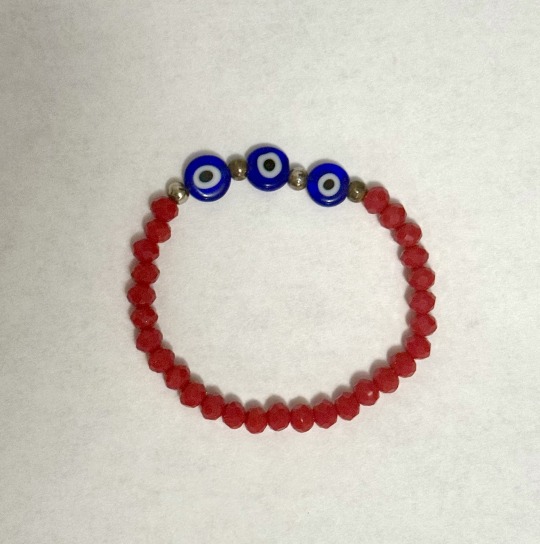
The bracelet is supposed to hold all of the negative energy that is being thrown at you, which then causes it to wear down, and thus fall off on its own as its supposedly overloaded with bad energy. And once it falls off you're just supposed to leave it alone as picking it back up could cause you to absorb all the negative energy.
Here's another shot of Danny wearing the red bracelet, though I can't find exactly what this event is, I'm pretty sure it's part of the Brave New World press tour. Again, I couldn't find any pictures of him with this bracelet from before then (I just quickly skimmed his instagram and no luck) so I'm guessing it was something he either bought or it was gifted to him right around the beginning of the Brave New World press tour since he (or if he was gifted it, whoever gave it to him) knew he would be experiencing new levels of fame because of his first MCU movie appearance. So I think that Danny is protecting his energy from any negativity that would come with his growing fame.


TLDR: Danny's red bracelet is meant to protect him from bad energy, though it isn't a strictly religious practice it is something that is common in Mexican culture.
#ro answers#this one is a bit shorter since there's less to explain i think#i also am not super spiritual so I could possibly be missing somethings so please correct me if I'm wrong#usually you can find bracelets like this pretty much on every corner in Mexico especially in touristy areas#and it's an open practice so anyone can use one of these#or even make one if you know anything about making friendship bracelets#again let me know if you want me to explain anything else!#curious anon#danny ramirez#joaquin torres#falcon#the falcon#mcu
16 notes
·
View notes
Text
anyway here's my thoughts on veilguard.
i liked it! i really, genuinely enjoyed it. there were moments that made me cry and truly moved me. there were plot twists that really surprised and shocked me. i felt emotionally impacted by the game. i love so many of the characters - both companions and npcs. it's beautiful. it's fun to play.
is it a perfect game? of course not! a) there's no such thing b) gang, i thought we knew this?? it's a game that's been in development for a decade, more than 3/4 of the team got laid off, it's had its usp constantly switched around lord knows how many times. it was never going to be perfect! i went in with my expectations underground and came out with a game i liked much more than inquisition.
neither inquisition nor veilguard were ever going to be like origins and da2. the creative team changed massively between those games. but also, the world changed! the industry changed! the climate in which people were working changed! for goodness sake there was an entire pandemic!
we were never and are never going to get games like da2 and origins again because the world is different now and that's ok. it's good to have new things!
could there have been more conflict in veilguard? sure. could it have been more politically and socially sensitive? maybe. but you know what? i work in media and i know how incredibly fucking hard it is to get any kind of purse-holder to sign off on one explicitly trans character, let alone nine (by my last count): specifically and lovingly designed across a wide spectrum of voice and appearance to illustrate that non-binary is not 'girl-lite' or a third gender, it's just not binary.
we went from vivienne being BALD in inquisition because they couldn't be fucked to design afro hair to a game where it is literally not possible to have an all-white or an all-male team for the first 5 or so hours of the game. one of your team members is a south asian woman with a prosthetic leg and at no point is her disability fetishised or exoticised.
god knows its not perfect but gang i really don't think y'all are recognising how fucking much good stuff we got in this game. literally, please, give me the title of another AAA game that has this much explicit trans rep. that has this many major characters of colour written with care and thoughtfulness. this many companions who are people of colour and essential to the plot. do you know how hard that is???? and everyone got fired!!!! it took 10 years!!! despite everything they got all this through!!!
like. it's not surprising to me the game is gentler than earlier entries in the series. earlier entries in the series are also, often, VERY RACIST. as far as earlier entries in the series are concerned: transgender people don't exist (except Krem, of course, but he is one character in a very big game). they are so obviously trying so hard and in a landscape where i literally cannot think of any other game of this scale and budget that is trying at all, yeah, i'm giving them a pass!
the things that drove me nuts in previous DA games were the christian fascism, the genocide apologism, the white supremacy, the 'peaceful protest' crap, the copaganda. veilguard doesn't do that and it's amazing and heartbreaking to me that so few folks in the fandom seem to value that.
there's this thing that happens whenever a piece of media is actually, truly diverse where fandom attacks it much, much more savagely than media that is actually racist, sexist etc (supernatural vs steven universe, star wars vs dream daddy, etc). people translate the fact that it takes them a little longer to connect with characters they're unused to seeing in fiction into meaning that the art is 'objectively bad'. and then assholes with money use that violently negative reaction to justify continuing to make games without trans people or brown people or a majority of female characters.
"look! veilguard did that! nobody liked it!"
please. consider why you are reacting so much more harshly to a game like this than you did to a game where you literally led a catholic inquisition, planted your flag in indigenous people's land, and had the power to enact military law on anyone unlucky enough to come across your army of religious zealots, up to and including executions.
no one is perfect. fandom isn't activism. consumption of media isn't activism. you're allowed to dislike things and you're allowed to yell about it on the internet and it's my responsibility to block content i don't want to see. i get that.
but just in case anyone else is feeling the way i am: i liked veilguard. i think they tried really hard. i think a lot of the team got fucked over by asshole bosses and worse executives. i think the game obviously got cut short and rushed, which we knew before it came out. and i still think they wrestled a fun, emotionally impactful game out of that housefire, and that that's worth celebrating.
23 notes
·
View notes
Note
I’m very 👀 about the version of King Arthur that lives in your head which you mentioned in the tags of that post about living weapons. Would you mind elaborating on that take on the legend?
i mostly think this about the "and future" part of king arthur, and specifically in an urban fantasy setting where people Know the king will/has returned. How many leaders claim they are the reincarnated king arthur? how many actually think theyre arthur vs how many are just using the myth to further themselves? and the living weapon thought comes into play with the question "how are they treating their children?"
An Arthur claimant has two children, a son and a daughter. "Its alright," he thinks to himself, "as long as I know where Modred is I will be fine, and I can always kill him young." A slightly more progressive claimant thinks "Okay, but which one is Mordred?" And he raises his children in that state of blind arrogance. How isolating would it be to be raised with the assumption one day you will kill your father? and if you excel at fighting, if you intuit older languages, if you show signs of being slightly better, if people start to whisper that you are Arthur and not your father...
And what about the child that gets sent away from [insert modern city here], or is entered into the foster system, or was simply raised by a single parent? They go back to modern!Camelot with the expectation of a family, of a place for them, and good work to do, only to return to the assumption they are here to kill their father? To return to a good king, who they do not want to kill, or to return to a bad king, who they must kill?
and if the actual arthur remembers they are King Arthur, what kind of resentment would grow in their heart as they watch men, who are poor men and worse kings, claim to be arthur? As they walk through the slums and ruins of modernity, they think to themselves "None of the claimants are trying to stop this or fix this. What do they think I did? What legacy of mine are they trying to emulate?" And the burden of the myth itself, of the tellings and retellings of it, the expectation of King Arthur of Camelot-- and for Christianity to have changed as well!
So Arthur in my head exists solely as a weapon. They have no family that loves them and no place to turn to once their father finally fears them enough to kill them, they emerge into a different world. Its the same city-- but no one knows who they are. People still flinch when Arthur come near, but everyone flinches these days. Arthur start to make connections. Other people on the street help them find soup kitchens and food pantries. Arthur starts to make friends. Other people help them realize what their father did to them wasn't right. Arthur start to look at the city. Other people talk about the old days and the new days and how the City should be run. About lifting people up and bringing back the city council. About homes and clean water and food on the table. Arthur starts to think about being King.
#realizing how much i love italics for emphasis through this post#this is genuinely the first time ive tried to write this down#before its been 100% rotating arthur in my mind#tanoraqui#arthuriana
64 notes
·
View notes
Note
I do think it’s important to clarify in your OP about the house bill that this is anti-trans legislation first and foremost. while it’s of concern for alterhumans, it is very deliberately being proposed as a way to frame trans people as animals & target trans kids—the author of the bill doesn’t actually care (and probably doesn’t know) about alterhumanity.
This bill will be used to prop up transphobic laws, and probably isn’t intended to be passed at all. I don’t think removing or ignoring that context is appropriate.
- a trans therian
I was going to make a reblog about this exact thing, but I'll say what I was going to say there here instead because I think it's important to make sure everyone gets the chance to see this. This is going to be long because I tend to ramble. TL;DR: Conservatives are not framing transgender people themselves as animals, but their arguments about/beliefs regarding people who identify as animals are absolutely deeply rooted in transphobia, which itself is deeply rooted in a fear/hatred of any "divergent identity." These two concerns are very closely entwined and are part of the same fight (the fight of "just let people be whoever they are"), but are not in and of themselves the same in the sense that this lawmaker is trying to target transgender folks with this specific bill. What makes this bill particularly concerning is the fact that it treats nonhuman-identities as their own separate issue, along with the media coverage it has been getting, which could easily spark other more "viable" anti-"furry" bills to be written and potentially passed in more conservative states across the country. However, this is not a time to panic, but rather a time to be vigilant and start thinking about how we need to prepare to defend one another against whatever comes next.
The fight for trans rights certainly still needs to be at the forefront of our minds, and we also need to be watchful for this threat that is creeping out from the cesspool that is the conservative need for any kind of new "monster" to blame society's problems on.
-Sincerely, another trans therian.
The whole "litterboxes in schools/students identifying as cats/animals" thing started with conservatives who said "if we let people identify as another gender its only a matter of time before people start identifying as animals." These people are well aware that transgender does not mean somebody who identifies as a different species - their concept of nonhuman identifying folks absolutely is rooted in transphobia, but is not in and of itself necessarily about transgender folks.
Reality is, anti-trans legislation and anti-"furry" (read: therian, otherkin, transspecies, etc. - though furries who aren't part of these labels would ultimately be affected as well) legislation are two sides of the same coin - but they are still two distinct sides. That coin is the "divergent identities" coin (and really has many facets, not just two... so... perhaps more of a "divergent identities" cube?), as I'll call it. Anything that isn't cis, het, christian, human-identifying, etc. would be considered a "divergent" identity - a disorder, an illness, something to be cured, something to be eliminated.
Yes, anti-"furry" clauses have up until now been wrapped up with anti-transgender bills. That's conservatives trying to, pardon the horrible cliche, kill two birds with one stone - but one bird they are assuming exists/believe exists because of a sensationalist story, not because they necessarily know it actually exists. Make absolutely no mistake though, now that even the slight possibility of nonhuman identifying folks is on their radar, they are going to work to - in their mind - prevent it, and "cure" (read: eliminate by whatever means they feel necessary) it for whoever already fits that description.
Up until now, it's been a side issue. Something to just tack onto anti-trans bills. The fact that some jerk of a lawmaker decided that it was a strong enough issue on its own to create its own bill is concerning because this marks the first time that it is being treated less like a hypothetical or a side problem, and more like it's own separate issue worth addressing.
However, these two are part of the exact same fight, and cannot/should not be considered entirely separate. The fight is not just about "let trans people be trans," the fight is about "let people be whoever they are." That includes being any sexuality other than allo-het, that includes any religion other than christian (not necessarily an "identity", but still), that includes being anything other than cisgender, and yes, it includes identifying as any species other than human. The focus has recently been particularly targeted at trans folks, but remember that before it was trans folks, it was anyone who wasn't straight.
Conservatives always need a "monster" to defeat. They rely on the outrage of the ignorant and the bigoted in order to get what they want. Its why so many of their talking points aren't really about the economy or infrastructure but instead are about things like abortion, "illegal immigrants," non-Western nations in general, religions that are seen as "foreign" or "satanic," and any identity that isn't considered "normal." The reality is, issues like poverty, poor infrastructure, and prevalent violence are issues that can't just be solved in a day - but humans like quick fixes, so some folks (especially conservatives, though they're certainly not the only ones) think if they can blame all of these issues on anyone who is considered an "other," then many people will be quick to follow them in trying to eliminate the "other" and just push aside all of the real problems that continue to, in someway or another, benefit the people in power.
It only takes one conservative with even half a braincell to decide to google "people who identify as animals" after seeing that a bill was penned to target this specifically, to discover that we therians/otherkin/transspecies folks/etc. really do exist and that the identity is starting to gain more traction especially among youth (thanks, TikTok). I don't think the guy that penned this bill is that one conservative (this dude apparently once tried to create "bigfoot hunting season" so. y'know. i don't think he's doing much research about anything lmao), but with the media attention this bill has gained, it's only a matter of time.
HOWEVER - THIS IS NOT A TIME TO PANIC. I literally cannot stress this enough. Panic is not the response we need to have, but rather vigilance and preparedness for the day nonhuman identities eventually do find their way into the spotlight so that we can be ready for whatever we need to do to fight back against whatever future bills may follow.
67 notes
·
View notes
Text
The (Dysfunctional) Holy Trinity Theory
So random thought/theory that sorta went into a rabbit hole. I was thinking about how the Variya situation worked as we know from K.F. since she's supposed to be dead by Adrest's account, and she's clearly not. I used to think Karma was pretending to be her... until I realized Karma making its presence known is WILDLY different than the few moments we see Variya doing it. Which lead to me to think that she probably did the classic mad scientist move of backing up her conscious/soul in the Core and became a part of it and the Karma Files doc that Adrest had was before she decided to pull that shit.
Alrighty cool, then it made me think maybe Karma and Variya being the god/leader of the Core works kind of like the holy trinity. Where they are separate beings but they act as one God. When Flora failed at Eclyssia Pyramid and had her meltdown on the monitor we see both Variya and Karma appear and the very ominous anniversary picture of Variya where we see on Aelita's photo an transparent eyeball which is an obvious reference to her being marked by Karma at the end of Renegade Ch.0. So it's clear that they work together.
And then just to double check my sources I saw a symbol of the holy trinity which I thought nothing of until I noticed the shape and well...


I always thought the core was supposed to be a sci-fi version and very simplified version of the Creation Glyph (which is probably inspired by the trinity anyway) but this is way more specific. We already had a Karmafied version of the Creation Glyph in Aelita's platinum route anyway. Could this be just a coincidence, probably, but also could be intentional.
So to keep this theory brief, that the current high players in The Core represent each aspect of the holy trinity.
The Father (or the mother in this case) = Variya- I feel like this should be self-explanatory, she created this system and assigned roles to her followers. According to the Space Hags, Variya is their master and queen.
The Son = The Interceptor- Having Adrest's soul, you know Variya's literal son helped narrow this down. Jesus was sent to earth to be a man in order to atone for the sins of humanity. The Interceptors are humans given authority by the system to rewrite fate and have the choice to save or condemn humanity. Resurrection is also an obvious parallel between the two. Finally the Space Hags (god they nails this shit together) former interceptors after finishing their mission ascended to godhood.
The Holy Spirit = Karma- The holy spirit has been super hard to explain/understand for me personally, so here's this link to a comment that's a good summary: https://www.reddit.com/r/Christianity/comments/bdy0ca/comment/el2cynx/?utm_source=share&utm_medium=web3x&utm_name=web3xcss&utm_term=1&utm_content=share_button
Karma controls the fate of every person and just an disembodied eyeball lacking a physical form (as we know right now.) They are the controller of the Core and as we see in Renegade can talk and forcibly lend power to a person that it marks.
Okay, I'm tired and I'm turning 23 tomorrow so let's wrap this up. The 17 overseers besides Adrest, Nymeria, and Vitus throw a wench into this, but they probably follow Variya/Karma, so it may work (idk if Vitus does, but that's another story entirely). This trinity is dysfunctional as shit bc of Variya being sus as all hell, Karma forcing people's fate and making them Karma beasts in desperate situations, and the existence of Renegade Interceptors, Interceptor like Crescent who only cares about her goals, and how non-Variya Interceptors like V or psuedo-interceptors like the Mysterious Figures fit into this. I feel like that might be the point, it's a computer-based system attempting to recreate god being led by people who are morally dubious at best, despite the best intentions (Nymeria, Space Hags) to Vitus "Indraid "Sirius" Theolia. Sorry for the Theology lesson in my funny Pokemon fangame, but I gotta let my delusions out that's going to be wrong in 5-9 months (hopefully) See you!
#pokemon rejuvenation#pokemon rejuvenation theory#v13.5 spoilers#rejuvenation theory#this really came up from making oc lore for this game HELP ME
12 notes
·
View notes
Text
Beginner Class - Correspondences 101
Ancient Craft & Occultism
Correspondences 101
By KB

Introduction
Welcome back to another lesson! Today, we're diving head first into the world of correspondences. What exactly are they? Why do we use them? We're going to discuss that and more in this lesson! Let's get to it.
What Are Correspondences?
In essence, correspondences are objects or aspects of objects that represent symbolism in direct correlation with a specific energy. Practically anything and everything has the potential to be a correspondence, therefore correspondences are subject to change depending upon the individual practitioner. Some of you may find yourself attributing certain emotions with colors - this itself is an example of a correspondence. Everything has its own energy, and using the energy that is in direct relation to your spellworking allows for that energy to be amplified and released into your work.
As Antoine Faivre (a French Occultist) states in his book Access to Western Esotericism:
"Symbolic and real correspondences (there is no room for abstractions here!) are said to exist among all parts of the universe, both seen and unseen....These correspondences, considered more or less veiled at first sight, are, therefore, intended to be read and deciphered....The principles of noncontradiction and excluded middle of linear causality are replaced here by those of the included middle and synchronicity. We can distinguish two kinds of correspondences. First, those that exist in nature, seen and unseen, e.g. between the seven metals and the seven planets, between the planets and parts of the human body or character (or of society). This is the basis of astrology - correspondence between the natural world and the invisible departments of the celestial and supercelestial world, etc. Next there are correspondences between nature (the cosmos) or even history, and revealed texts. Here we find the Kabbalah, whether Jewish or Christian, and varieties of 'physica sacra'....Ultimately the world stage is a linguistic phenomena."
Or as Pierre Riffard (a French philosopher) states in his book Dictionnaire de L'ésotérisme:
"The doctrine of analogy and correspondence, present in all esoteric schools of thinking, upholds that the Whole is One and that its different levels (realms, worlds) are equivalent systems, whose parts are in strict correspondence. So much so that a part in a realm symbolically reflects and interacts with the corresponding part in another realm. For instance, the Sun in the mineral realm is the counterpart of the Lion in the animal realm. The relation between A and B is similar to the relation between C and D. The microcosm and macrocosm are analogous, that is, equivalent, similar in their structures, even though they are outwardly dissimilar. The parts are in strict correspondence, closely knit together and closely interacting: thus feet/pisces, veins/rivers."
This is exactly why you use specific herbs, go for specific timing or moon phases, use certain colored candles, and much more.
Why Do We Use Them?
When raising our energy and directing our energy towards our goal, it's very useful to have elements that align with that as a means to amplify the energy. It takes less energy on the practitioner's end, as the natural energy of the objects being utilized is aligned with the energy needed in the work. A lot of it has to do with association, as that's a natural way for our mind's to process information. If you're doing a spell or ritual that is about healing, and you include a solar symbol or something orange, your mind may focus on a different energy rather than healing, which would interfere with the energy of your working.
It's important to make sure all correspondences are considered with your personal associations of things as a means to help you raise and direct energy.
Can I Make My Own Correspondences?
As stated above, the energies connected to particular items are known as correspondences, and they can be employed to increase the power and efficacy of your spell while also giving additional energy. These energies are influenced by a variety of elements, such as nature, colors, history, and culinary and medicinal applications. You would probably find at least one or two lists of correspondences for frequently used items in any book on witchcraft, especially for herbs and crystals. While the majority of correspondence lists are excellent, there are occasionally those that contain ambiguous correspondences, thus it is crucial to investigate any correspondences you are unsure about. Even if I wholeheartedly endorse the usage of these lists, especially for novice practitioners, how can we do away with them, particularly those in which we are unsure about the source of the information?
Look At Practical Uses
Examining the object's beneficial uses is the simplest method to get started writing your own correspondences. How do you utilize the item on a daily basis? What role does it play in the home? Take the broom, for instance. The broom's primary use is to sweep up dirt and debris from the house. Brooms can therefore be used to tidy up an area. Is the plant you're looking at utilized for cooking? What flavor does it have? What flavor does it add to the food? Is it able to glue the elements together, thicken, or color them? What is it used for if it has therapeutic uses? Does it relieve pain, calm rashes, improve focus, promote sleep, or treat infections?
Cayenne peppers, for instance, are hot and add long-lasting heat to the dish. They can also be used medicinally to reduce pain, increase metabolism, and hasten digestion. Based on these real-world applications, cayenne can be used to speed up a spell for a long time, eliminate rivals, or ignite your romantic life. We can begin to deduce some of their elemental correspondences from these practical applications. The cayenne pepper, which is hot and red, is related to the element Fire, whereas the broom, which is sturdy and purifying, is related to the element Earth.
Historical Uses
Once you have examined an item's practical applications, you might explore its history. Most things we use every day, especially those found in nature, are covered in folklore. To start figuring out other correspondences for an object, I advise consulting mythology, urban legends, medical books, and other historical documents. It takes time and needs critical thought to determine correspondences, but the effort is definitely worth it.
Scientific Nature
Next, start examining the object's scientific nature. The easiest way to do this is to use natural objects like plants, rocks, fungi, animals, insects, and other living and nonliving things that are present in your local environment. Where is the item often located? What features or qualities distinguish it from other things? What function does it serve in the ecosystem? Does it exhibit any distinctive behaviors? Take the flavor of mint. Almost all mint species develop swiftly and prolifically. If you don't watch them, your entire yard will be taken over. They are associated with abundance, prosperity, and fertility because of their prodigious nature. Some of these scientific correspondences are simple to infer, while others require some additional research.
Your Intuition
When determining an object's correspondences, the first three ways use logic; your intuition uses your psychology and emotions. Intuition is one of a witch's strongest weapons, although our contemporary culture frequently downplays its accuracy and trustworthiness. Start by wrapping your consciousness around the item in meditation before using your intuition to find correspondences. What does your intuition have to say about the thing? What comes to mind when you think of the thing you're looking at? Personal correspondence frequently starts in this area. At least for you, your personal connection to an object and the correspondences you create by employing your intuition have incredible power.
Consult With Spirit
Finally, you can speak with the object's spirit to learn more about its correspondences. The concept of animism holds that all things, both living and nonliving, have a spirit that we can interact with and form relationships with. This is easier said than done, and before attempting this kind of communication, you must be able to distinguish between your own intuition and mental chatter. It's normal for some witches, especially novice witches, to struggle with this correspondence determination process. This is an excellent chance for you to develop your spiritual gifts. Start by grounding and meditating with the object in issue, just like you would when using your intuition to determine correspondences. However, leave yourself open rather than putting your mind into the thing.
Keep the general mental chatter at bay and concentrate on the work at hand. Set out with the goal of listening rather than speaking. Depending on the object, you might hear it speak loud and clear in full sentences, or you might only see a flash of color or experience an emotion. But the secret is to approach this situation with no expectations. The item may not speak to you at all because you are not entitled to a dialogue with it. However, by building a relationship with the object beforehand, you can increase the possibility that it will communicate to you. Offer it gifts, communicate with it, take care of it, etc. Do essentially everything you would to make a new friend.
You will gain a strong understanding of how to employ the object in your own magical practice after combining these five techniques. Additionally, it will improve your magical practice overall and reinforce your bond with the object, enhancing its effectiveness as a component of your spells. The object will be considerably more likely to help you if you can communicate with its spirit.
#elder witch#baby witch#witchblr#witchcraft#beginner witch#dark witchcraft#astrology#tarot#aesthetic#divination#traditional witchcraft#green witch#witch stuff
96 notes
·
View notes
Text
Coptic Women's Headpieces: padded headbands and Palmyran strips
Neither of these have much (...in the first case, any) information out there to make their own post about, but they're both interesting.




The first are these padded headpieces. In the past I'd only seen the one made of leather with flowers on it in the V&A, which notes its possible usage. However it was only until recently when I began poking around on the French internet when I found more, and better yet, an undeniable depiction of a woman wearing the headpiece. Before this I'd seen some depictions that may be the headpiece being worn, but usually seem much flatter than these were made to be or like they're a more standard gold diadem.
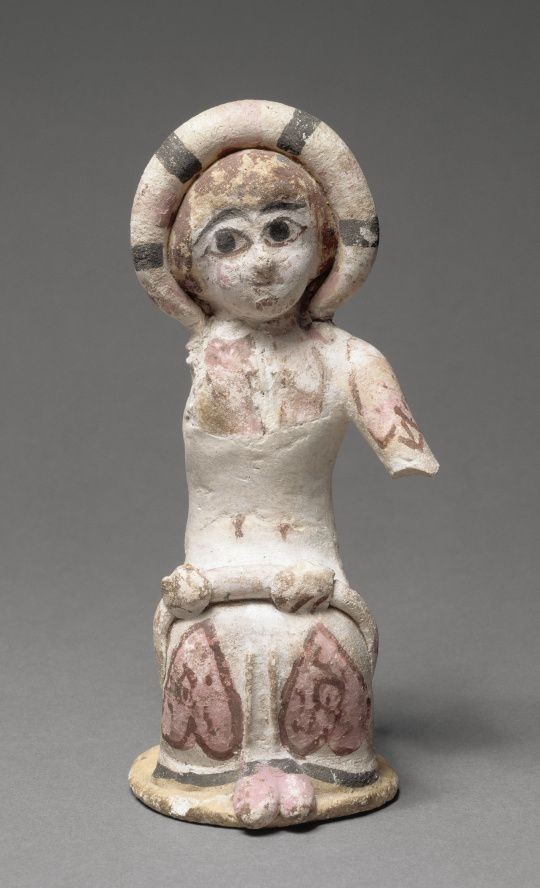
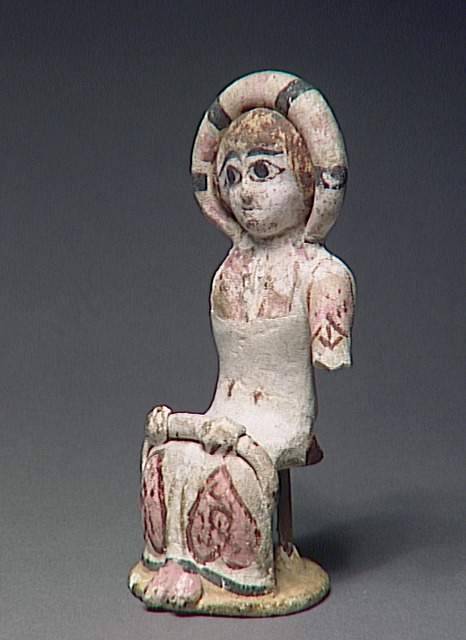
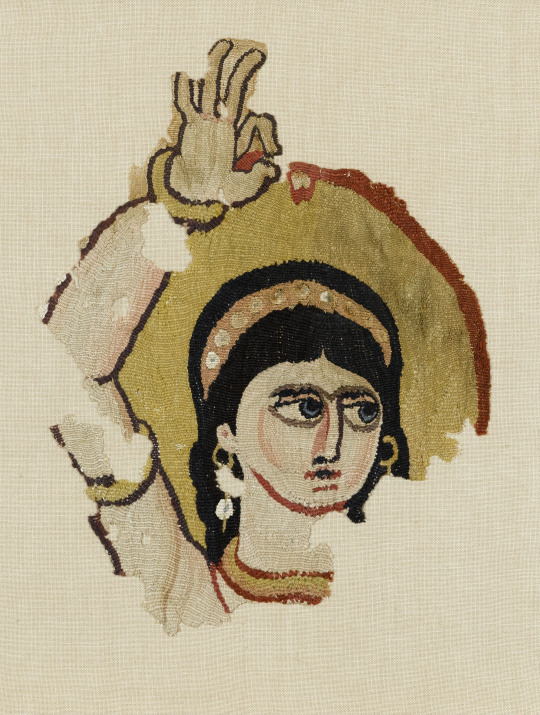
In addition to this, there are a few depictions of Coptic figures wearing these flower bud/petal crowns (more popular in the earlier part of Roman Egyptian art history), which makes me wonder if these were ever used as a base for those.
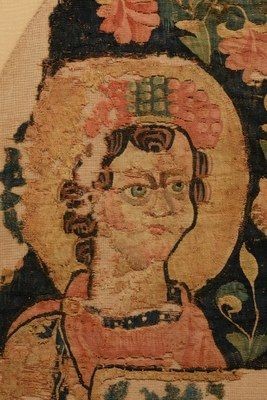
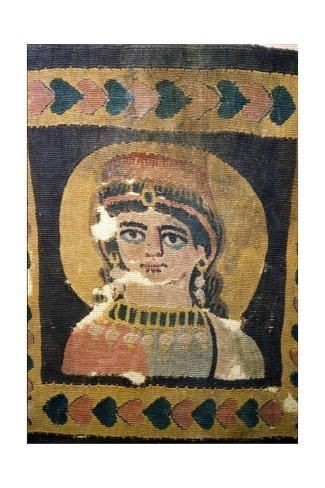
It's also possible this was out under the turbans worn by women in Coptic art. An example of a bust from Byzantine exists of a woman wearing a turban from Constantinople, and when viewed from the side it can be seen that the volume at the front of her headdress terminates in points near the nape of her neck/her ears. However, this bust also lacks the volume one would expect from the examples if a roll like the extant examples was used.

The other piece is one I noticed before, and isn't specific to Egypt, or originated from there. It seems to have come from Palmyra, and is fairly common in the funeral busts we have from there.
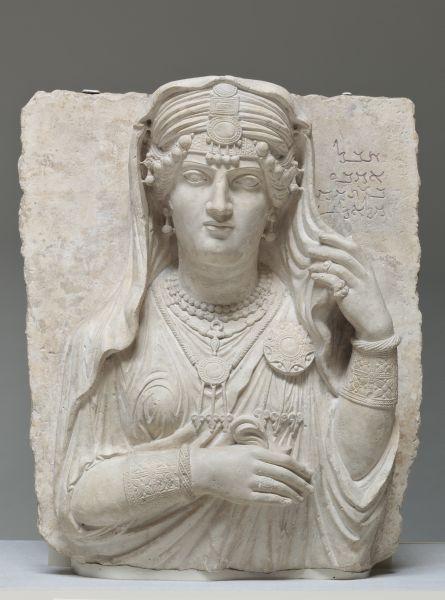
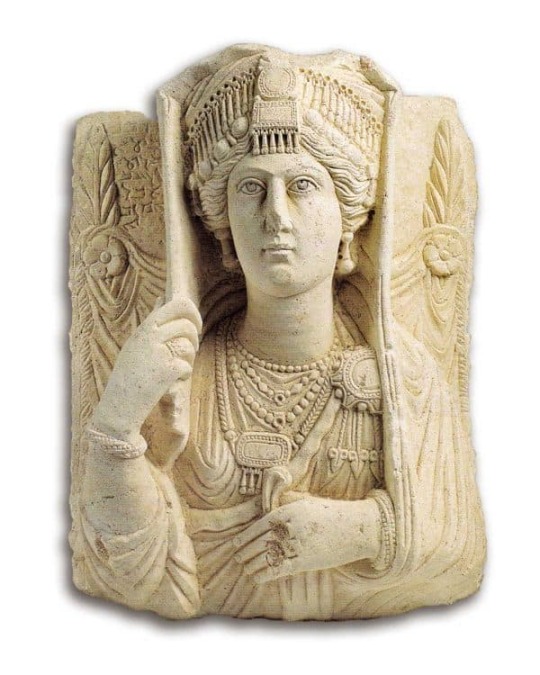
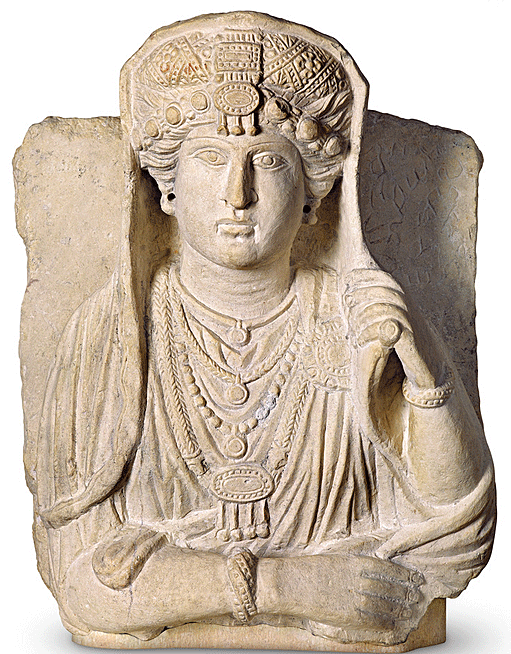
These are small plaques of metal and gems, typically with a few small beads dangling over the forehead. Currently it's supposed that they were attached to a woman's bun in some way.
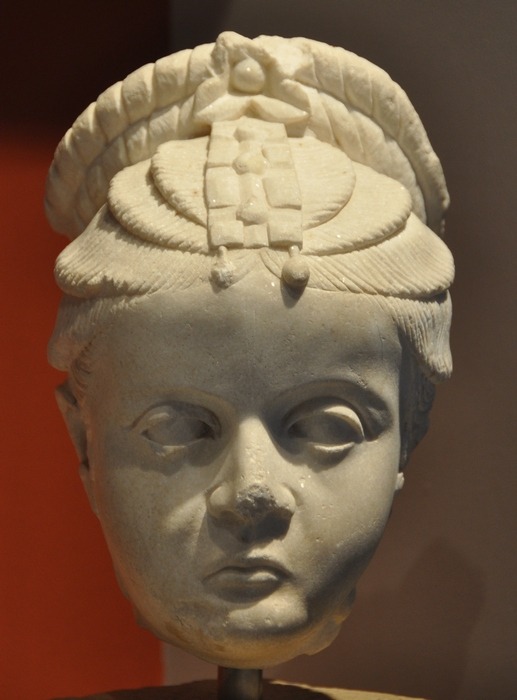
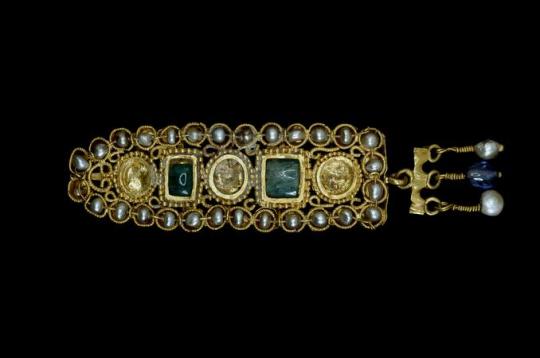
Here's a Roman-era Greek bust and a Roman- era Tunisian example.
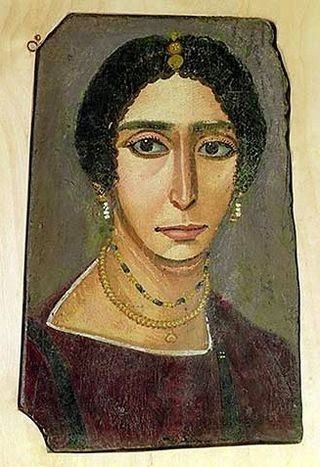
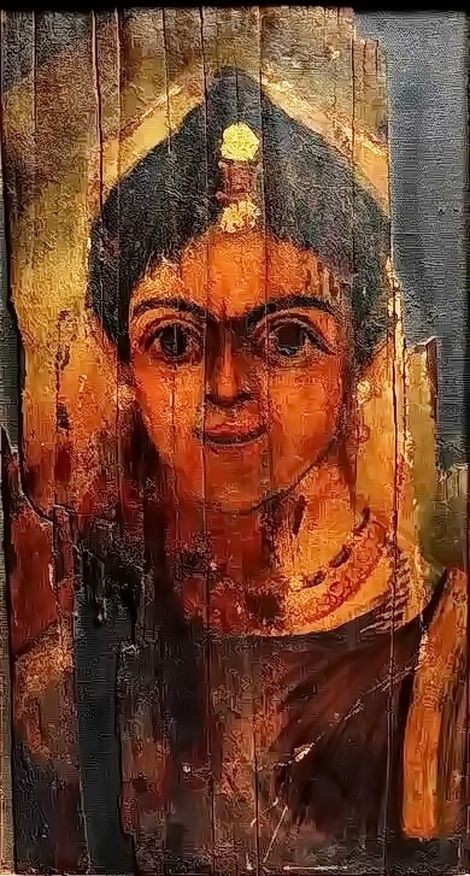
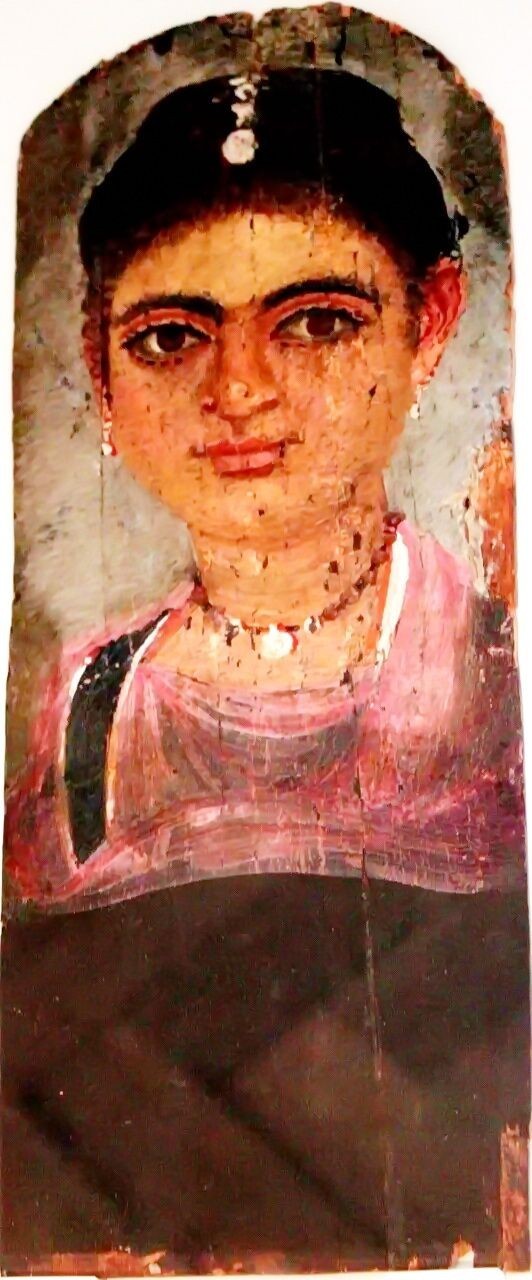
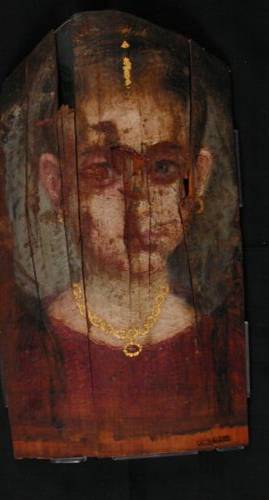
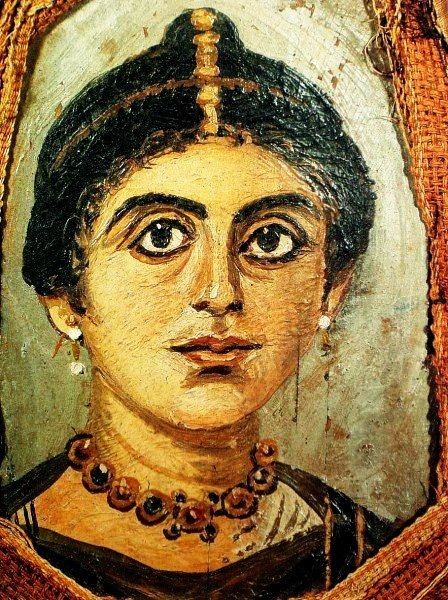
Heres some Roman-Egyptian portraits with similar head jewelry. So far, I haven't found a definitive later Coptic depiction of one being worn, but I don't think that means they stopped being worn before Christianization. It's possibly just a matter of what art has survived and what I've personally seen. Generally, Coptic jewelry is similar to the jewelry from earlier Roman-Egyptian examples, with some more unique examples and examples that were inspired by later trends in the Byzantine Empire.
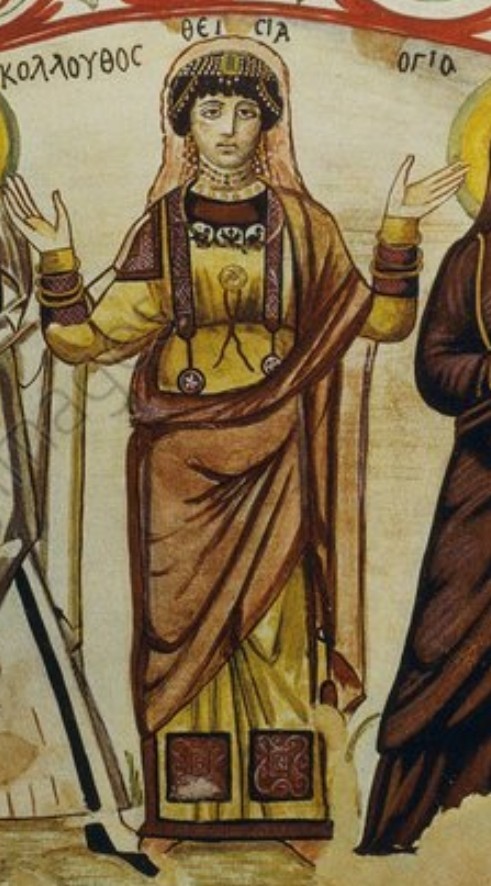
One of the possible Coptic examples is from the tomb of Theodosea (full disclosure: Theodosea herself was Greek Christian living Egypt, not a Copt in the sense we mean it now, but she's dressed in a way generally common in Egypt at the time. I use "possible Coptic example" here to indicate the contemporary cultural majority of Egypt, which is distinct from the pre-Christian cultural identity of native Egyptians). Theodosea here is identified by Engy Hanna as wearing some type of golden hairnet, with a green pendant with 3 hanging pearls and two strings of hanging beads attached. Because of her palla, it's impossible to tell if she has only one medallion attached to her hairnet or if this is a strip. The overall composition of elements (a cover over the hair, the two strands, center ornament, and a shawl over top the head) are very similar to Palmyran headdresses, though she doesn't wear a turban or the patterned fillet they do.
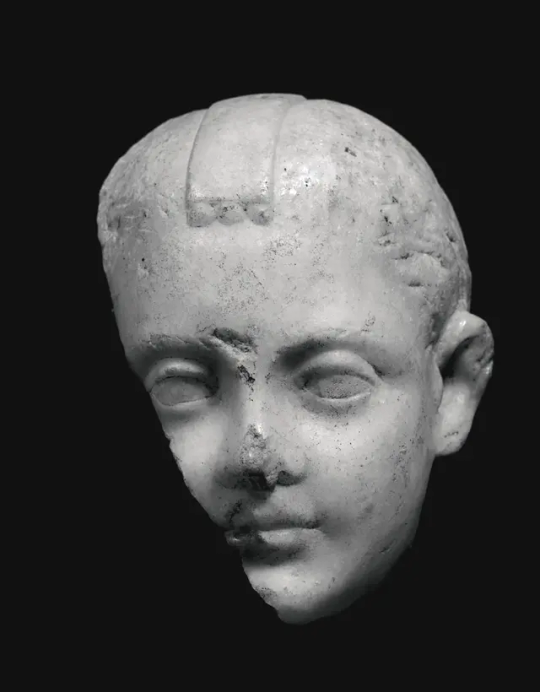
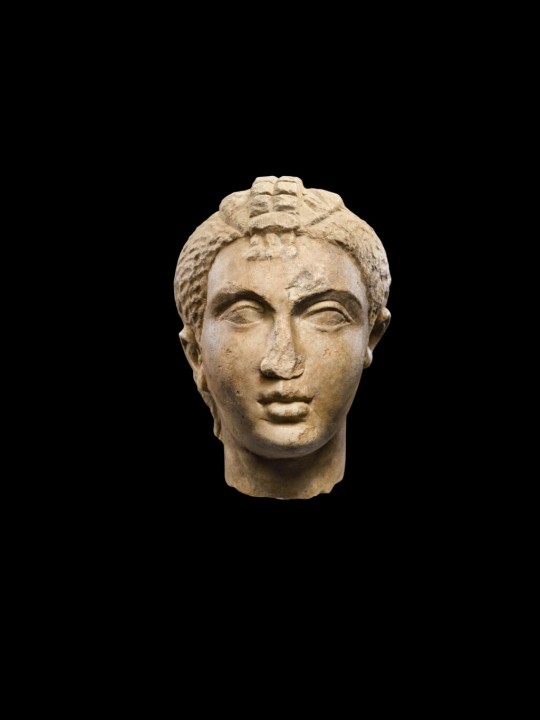
Recently, I found a bust on an auction site labeled "Roman, probably made in Egypt" from the 1st century, with this ornament but made of a more pliable material- probably fabric. And another on the same site, maybe Egyptian (the information mentions both the terms Gandhara and Greco-Egyptian), with the more typical jeweled look, 2nd-3rd century (which is more into the swing of Christianization in Egypt).

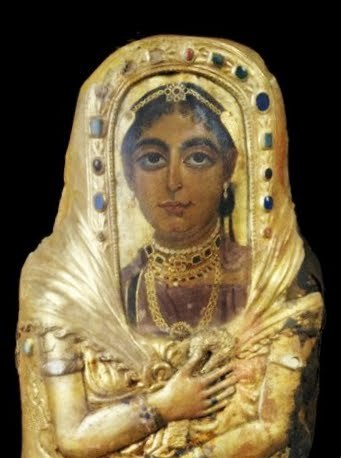
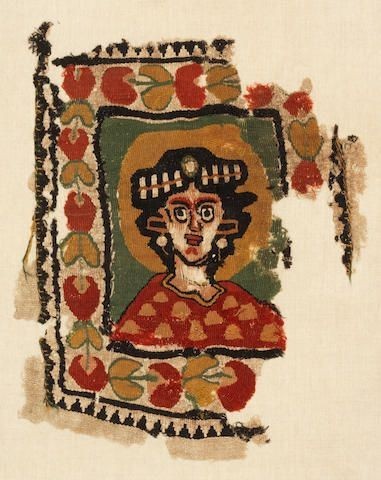
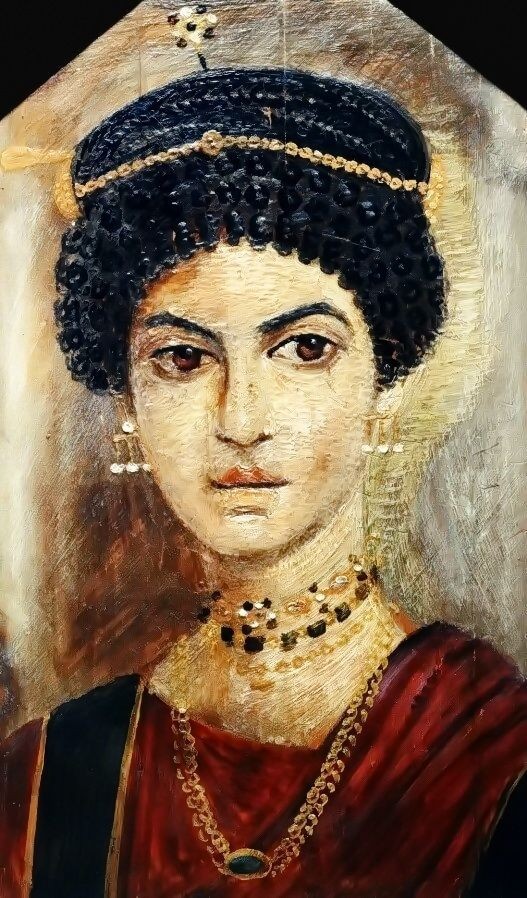
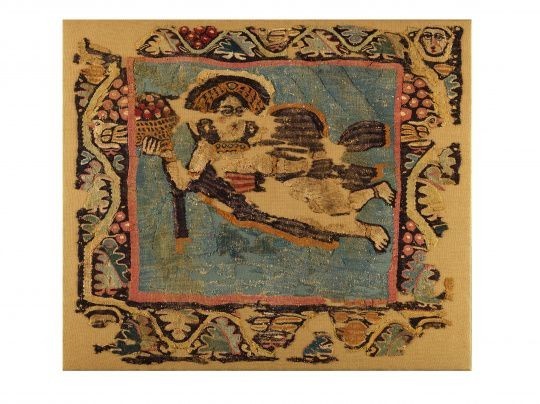
The last aside is another jewelry piece resembling that of Palmyra, though less so: a kind of circlet that appears to be made of chain with a center pendant. The star pendant worn by the second woman also notably resembles the pin holding the strip to the Greek girl's updo. The hanging strands of Theodosea are more blatant, but it's possible these were elaboration on the fashion. This style of jeweled forehead circlet, unlike the headband and strip (I have seen art of Syrian and Egyptian women with a strip, as well as Nubian art of women with a fillet/circlet and a center strip. The latter seems to be a more widely used item than the former two, which I have only seen one depiction each of so far), has remained consistently popular in West Asia and North Africa. Additionally the padded band worn by one of the Palmyran women featured here could be a related item to the padded headband; to know one would have to see the back of her head or find an artifact connecting the two. Even if a relationship can be proven between the Byzantine, Palmyran, and Coptic padded fillets, there is no clear indication of where it originated.
*I am a Copt, and if you are not, do not tag this post talking about "recreations". I find that offensive given the actions taken by Albert Gayet in regard to the clothes he took from graves. It is a simple boundary and you will not "enlighten" me to see how it's fine.*
Sources/Further reading:
https://art.rmngp.fr/fr/library/artworks/femme-assise_terre-cuite_polychromie-technique
https://art.rmngp.fr/fr/library/artworks/bourrelet-de-coiffure-postiches_laine-textile
https://art.rmngp.fr/fr/library/artworks/bourrelet-de-manteau_laine-textile
https://art.rmngp.fr/fr/library/artworks/bourrelet-de-mantelet_laine-textile_textile-matiere_lin-fibre | sources for 3 of the padded fillets and the figurine
https://collections.vam.ac.uk/item/O353014/pair-of-fillets-unknown/
https://www.metmuseum.org/art/collection/search/468716 | the marble bust
https://www.persee.fr/doc/bch_0007-4217_1969_num_93_2_4903 | in German, has photos of carvings with the hair ornament
https://www.sothebys.com/en/auctions/ecatalogue/2016/ancient-marbles-classical-sculpture-art-l16260/lot.59.html | carving of the short haired child
https://www.sothebys.com/en/buy/auction/2022/ancient-sculpture-and-works-of-art/a-roman-marble-portrait-head-of-a-girl-circa-2nd | carving of a girl with a jeweled strip, may be Egypt as the notes say an image of it was published in a work on Greco-Egyptian art and the girl has an "Isis lock" hairstyle
https://www.jstor.org/stable/4241695 | overview of Palmyran jewelry
https://www.britishmuseum.org/collection/object/G_1903-0717-3 | Tunisian example of strip
https://www.livius.org/pictures/greece/thessaloniki/thessaloniki-museum-pieces/thessaloniki-portrait-of-a-girl/
https://womenofegyptmag.com/2020/02/11/what-coptic-artefacts-tell-us-about-women-in-ancient-egypt-part-one/
#Coptic art#Coptic culture#Late Antiquity#Late Antique Egypt#Masr#Copt#Actually Egyptian tag#Cipher talk
109 notes
·
View notes
Text
just finished scale so here are my immediate collected personif thoughts
yeah cities are eldritch abominations their hearts beat Faster and they get *more* youthful and flexible and energetic as they age and this is why they just don’t fucking die
on the other hand companies basically go through the same stages of growth as people. their average lifespan is less than ours though lmao
city exchange is supplying the other two thousand something watts that a person uses on top of regular bio metabolism to exist in society
city exchange also makes people more similar to cities. cities are basically immortal (technically a-mortal but good luck), being in exchange with a city makes people live longer. cities don’t reproduce very often or at all, people in cities generally don’t have as many children as people in the countryside
i want to insert pseudophysics into my doctrine. unified perception theory if you know a personif well enough (high enough levels of exchange) its impossible to distinguish between the avatar groupspirit and true body
the premise of personifverse that makes it different from reality could be that emergence more generally ALWAYS produces a consciousness that gives rise to the rest of the properties of the system, its just that systems made of people are the only kinds whose consciousnesses manifest themselves to us in a form we immediately understand. the -if in personif would become a suffix that denotes that the word is describing an emergent consciousness composed of the entities the word it’s attached to. the consciousness controlling ant colony formation (and the ant colony itself) would be an antif. we would be cellifs or neuronifs if you want to be more specific
the trichotomy would still be a thing in unified perception theory but it wouldn’t be a fundamental separation, and also probably influenced by christian ideas of the trinity. this isn’t related to scale but i did draw this shield of the trinity
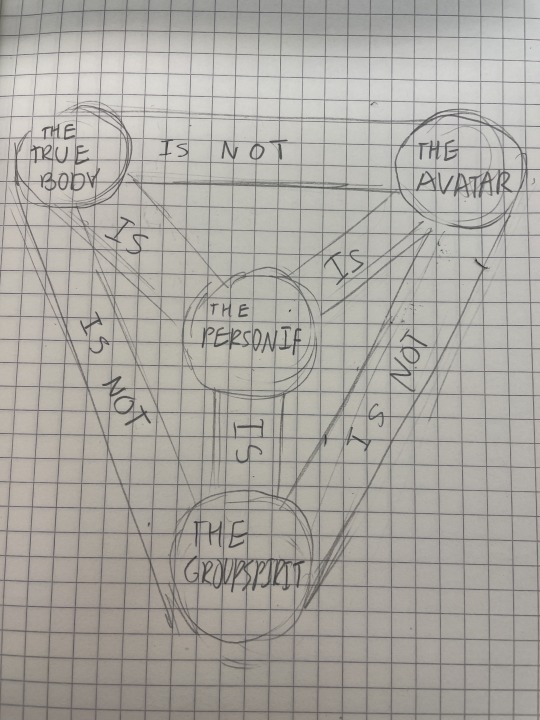
it’s not accurate at all but it was really funny to me in the moment
i’m keeping the trichotomy because it has a lot of downstream effects like causesplitting and second spirit systems that i need to keep too i am not in the mood to make new explanations
also about the avatar redundancy problem this again isn’t directly related to scale but it was marinating while i was reading. since i’ve been working on icrc’s actual character sheet i’ve realized it’s really boring if i leave personifs as passive or even ambiguous i need them to be active, the actions of an avatar (or done to an avatar) directly cause true body effects, and that is going to involve me taking away autonomy from the people who were the real reason things happened but i see no other choice
#man my physics brainrot is so bad im thinking about personifs like the 4 fundamental forces#personifposting#personif meta#nat’s personifverse#ideas#personif gen#cityspirits#corpospirits#i do want to make something similar to the trinity shield that is accurate to personifverse#for attributal purposes
2 notes
·
View notes
Text
The Trolley Problem in SMTIVA and why I keep choosing Dagda
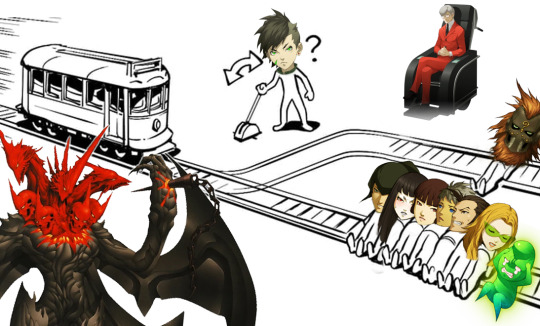
There are several ways one could analyze Danu and Dagda's philosophies (and in far more detail) but for this post I'll be talking in a simple and straightforward way through Pros & Cons with in-game evidence.
Personally, I see Bonds and Massacre's essential difference standing on 'I care for the now' and 'I care for a future with no suffering'.
-----Bonds-----
The price: - Dagda is replaced by a Dagda shaped by Danu - Humanity will continue to depend on religions thus the cycle of suffering continues for both humans and those who rely on human understanding (gods, angels, demons etc)
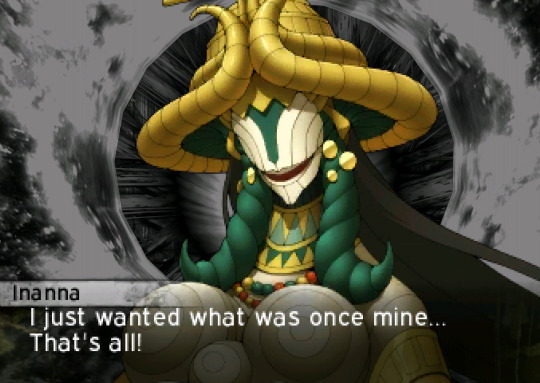
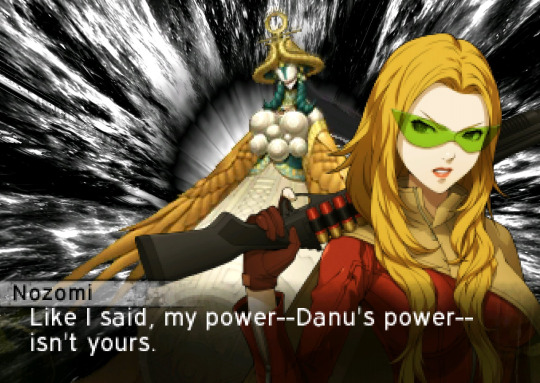
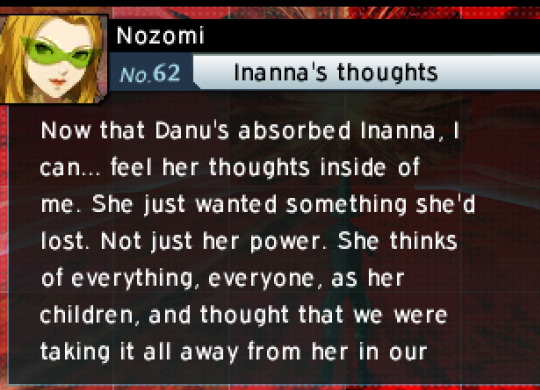





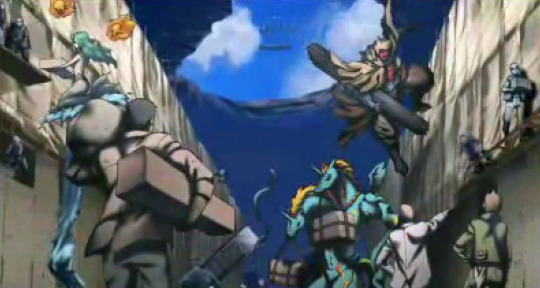
But you get! - The souls that were going to build the Cosmic Egg are set free - All of your teammates are alive with their sense of selves intact

It's an ending that favors the human side as it doesn't put the focus on blaming the humans but 'bad and tyrant' gods. Even though they become bad specifically from the observation done by humans.
Gods and demons will continue to exist by being observed and exploited and blamed on for their misery. But for Nanashi what matters is that his friends and allies are well and working together. For now.
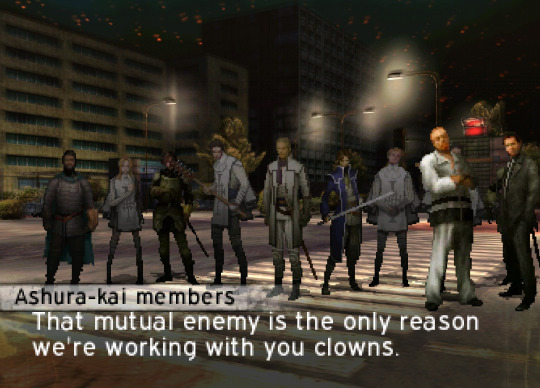
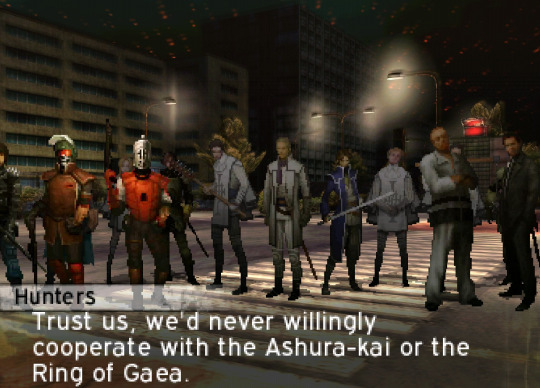
-----Massacre-----
The price: - Human souls will be sacrificed to build the new Universe - Your teammates are alongside the sacrificed and if revived, have a different sense of self

But you get! - Dagda stays as the original Dagda - Humanity will become independent and self-sufficient from religions, sets free those who rely on human understanding (gods, angels, demons etc)
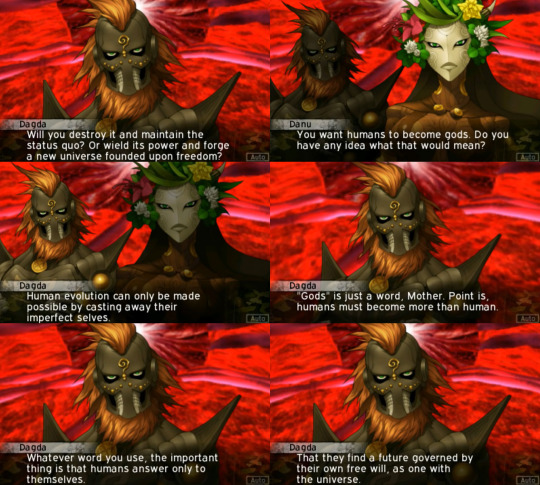

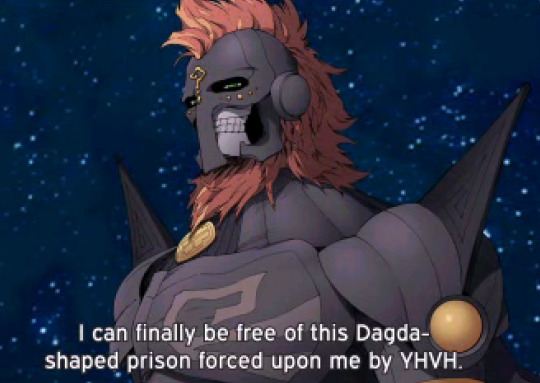
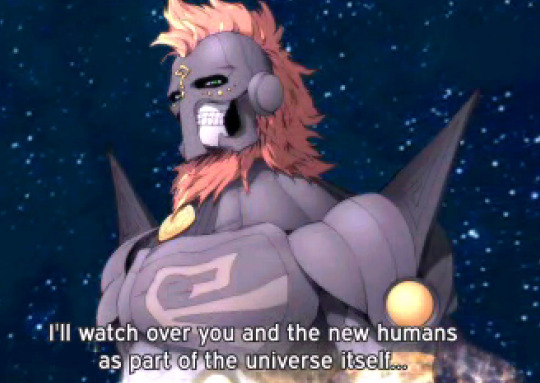
Here, Nanashi accepts solitude and taking on Dagda's god position for a future where religions and myths become pointless. No biases or influences that could twist the original nature of the world anymore so new humans will be born with unlimited potential of using the truth of the world for themselves instead of leaving it at the hands of deities. Unless an exterior force comes.
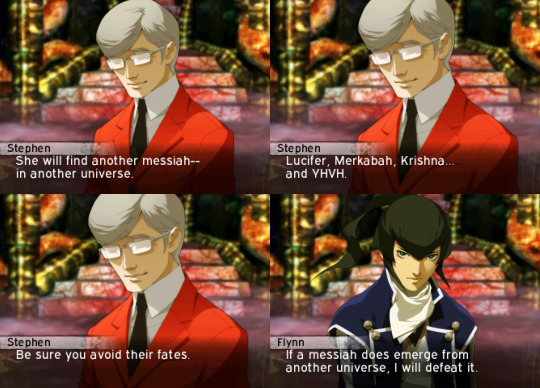
It's important to keep in mind that as cruel for his methods Dagda is considered, he doesn't favor a specific religion or way of thinking like how Law does and just wants Nanashi to avoid the root of his problems: the observation done by humans. To consider Nanashi as if he could be a second YHVH is to go against what Dagda is preaching for (and Dagda will still watch you as he disappears).
The best argument for this is shown in this summary from page 110 from the SMTIVA artbook (translated by dijeh):
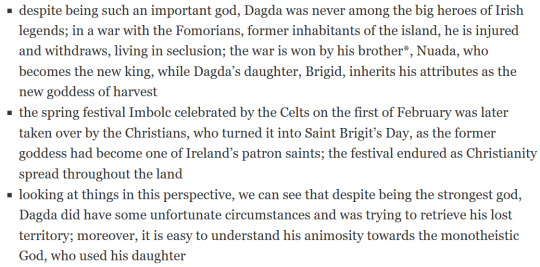
As sidenote, while Brigid isn't shown in the main story, she has a cameo in Tír na nÓg (aka the DLC area where Dagda makes it available for you to train), in which Nanashi can meet various Celtic figures from pre-Christian Ireland:

So if you are going to point out Dagda taking advantage of the mental state of Flynn and your Goddess, just scroll up and look again at what Danu does. They use the exact same method, with the real difference between them is that Danu's solution is an endless cycle of punishing and policing ideas that will keep being reborn from humans while Dagda wants to give future generations of humans the power to not depend on religions and on the same line, towards gods and demons the freedom of expectations to conform to what humans demand of them.
The irony is that Danu's kind and wholesome outcome favors way less groups in the long way than Dagda's despite the game constantly throwing at you that he is the most self-centered of the two.
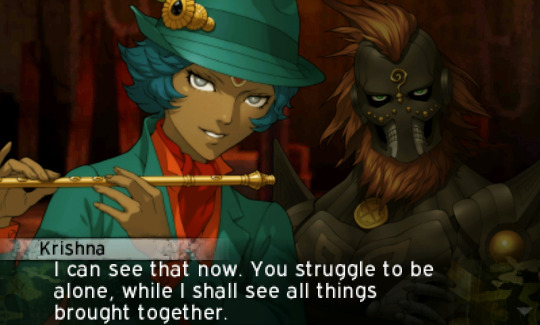
Krishna, the most fitting force to compete against Law and Chaos since hinduism is one of most popular religions (approx. 1.2 billion of adepts), advocates for the pagan religions to side with him so each gets its own slice of followers for a world order of polytheism instead of monotheism. It's an ending that favors deities associated to polytheism. Dagda does the opposite to Krishna: 1) uses the fact he is not a very well-known deity and hides in the Axiom from interference from other people and YHVH himself until he could meet someone with a powerful will as Nanashi so he can 2) force all deities and demons altogether to return to the nature.
Dagda's ending strips the powers and authority of all religions and gives them to humans.
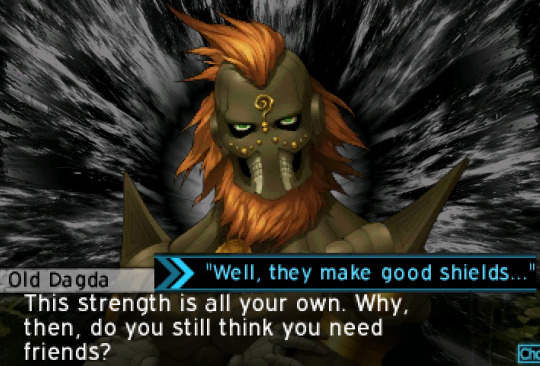
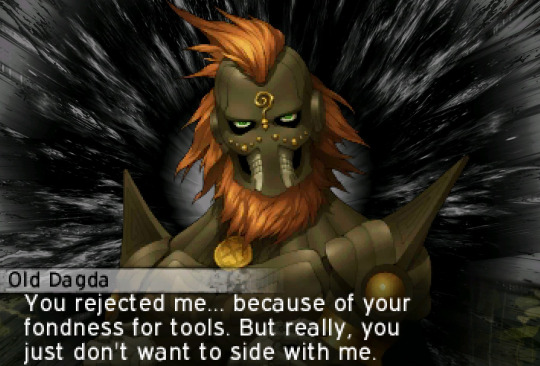
Now, obviously we also count that how a player considers the 'price' and the 'reward' will commonly vary from the theory (f. e. players picking a side for liking or disliking a character regardless of the meaning behind their alignment or viceversa).
In fact, SMTIVA validates this option as you can still see Nanashi being able to choose dialogue where he looks down on his teammates while also disagreeing with Dagda.
Meanwhile, Nanashi in Massacre is able to show compassion when parting ways with them as well.
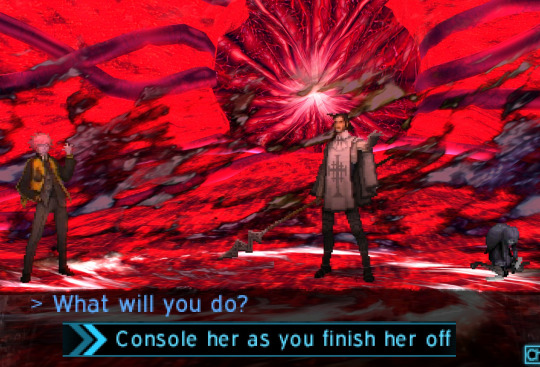

In other words, there's no such a thing as a route where Nanashi is 'locked' into a single type of personality. Nanashi can canonically choose a route for ulterior reasons beyond what Dagda or Danu originally wanted them to be.
The duality of being friendly out of selfishness or being aloof out of not wanting to be heartbroken are all possibilities.

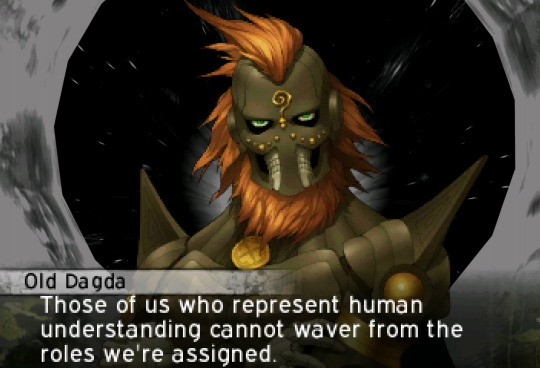
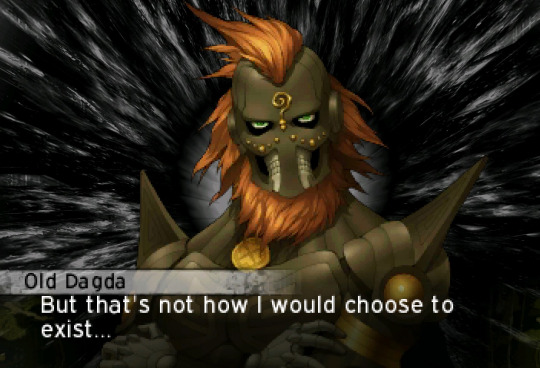
One could even say that the latter is present in Dagda himself, particularly from the ways you might be able to view his relationship and treatment of Nanashi.
To put it simply, the perspective of Dagda seeing a son in Nanashi after getting distanced from his daughter and Nanashi seeing a father in Dagda due to his orphan background and rather... unbalanced dynamic with Asahi and Boss.
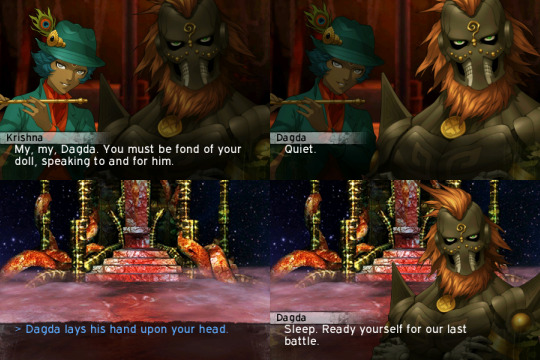
As how a certain quote goes, the opposite of love isn't hate, it's indifference. Taking into face value Dagda's grievances with influence caused by bonds with other people is similar to villifying the Chaos side without understanding the nuances of Law being what demonized it in the first place.
Dagda is intentionally made to be the bad apple of the game as a smokescreen for the player.
20 notes
·
View notes
Text
some misc. thoughts
my roommate warmed up some fish stew which unfortunately means that the apartment now smells like kelp. and that means my coffee now tastes like kelp
i've been feeling a little uncomfortable lately with how some people talk about feminist theory/body autonomy on here - not in the sense that i disagree with the ultimate point that they are making, but that i think any argument that completely alienates a very large demographic is not an effective, kind, or logical one. i'm specifically referring to rhetoric that depends on atheism and completely falls apart when applied to a religious world view. like approximately 85% of people in the world are religious + being religious is not an inherantly good or bad thing. it is just a belief system that has no implicit morality in itself. bodily autonomy should exist for the very simple reason that everyone deserves to have the right to make choices about their own bodies and i think it is supremely silly to say "actually bodily autonomy should exist for x/y/z reason that depends upon atheism being the truth". people (rightfully) get up in arms when religion is used as a reasoning for beliefs about bodily autonomy (see: christian doctrine relating to abortion) so i think it is silly to ignore the same flawed arguments when its coming from a perspective that is less socially fraught. idk i just think it makes for a poor argument and it is unkind and dismissive of other people's beliefs thats all
my cd player stopped working :-(
3 notes
·
View notes
Note
I would argue that it is impossible to disprove the idea of “any” creator deity because the definition if “deity” is so vague as to be basically useless.
But a specific description of a hid? Like the one described in the Bible as an obvious example? Or Zeus? That can be disproven. We know lightning bolts are t thrown by a guy on a mountain. We know the earth wasn’t made in 7 days. Etc.
But if someone is the kind of Christian that believes god is just “a feeling in their heart” or whatever? At that point a universe with that god in it is functionally the exact same as one without it. Meaning that god doesn’t do shit
Then allow me to reiterate my point: if I believe in a deity that has created the world in some fashion. A deity I also believe has made a covenant with my ancestors, one that I am required to keep. You can try and prove or disprove the existence of said covenant, but perhaps proving or disproving the mere existence of this deity is simply impossible. And yet, it doesn't mean its existence isn't meaningful to me. I believe that G-d does, in fact, "do shit" - even if He doesn't conduct extreme miracles. According to certain veins in Judaism, G-d is constantly holding the natural world together, making sure the natural laws will continue to function. This idea can't be scientifically disproven, I think - thus placing any theory about it decidedly outside the realm of the scientific method. It's not the purpose of the scientific method to prove whether there is a G-d, or a demon that messes up with your experiments. If it can't be disproven, it's just not really about science.
Now, in relation to your other ask (because I'm not going to answer them separately) - let's first copy its text here:
Belief in a flat earth isn’t inherently harmful either, you’re allowed to be wrong, at no point do I think we should curve people to believe things because they’re true, because frankly most people who are dedicated ti being wrong won’t be convinced regardless of evidence, But it should still be recognized as being untrue by anyone who cares about objective reality.
I think this actually completely ignores the distinction I've made in my previous answer. But since it took me some time to actually go in that direction when writing my answer, I suppose I can't blame you for that.
I've made a distinction between a theory, which is in the realm of science, and a belief, which isn't. The distinction is simply: can we use the scientific method to disprove it? Is there a conceivable way to do so? If that is the case, then whether or not the theory is objectively true depends on whether or not it was disproven yet. The theory of the Flat Earth, as we shall call it for now, is possible to disprove with the scientific method - as is it's more widely acclaimed competitor, the theory of the Round Earth. If by sailing west you find yourself back in the east, you have proven that the Earth is round. If that doesn't satisfy you, then the way objects on the horizon work, as well as seeing the world from orbit, should prove to you that the theory of the Flat Earth is false, objectively. From now on, anyone who believes it might very well be completely harmless - but they are also objectively wrong, as has been proven.
On the other hand, the belief in a higher power of some sort who created the world isn't actually possible to disprove - especially if part of this belief includes It being imperceivable. That would mean that this isn't a scientific theory, and if I went to present it as one among physicists they'd rightly dismiss it. However, being impossible to disprove doesn't mean it's immediately false. In such a case, the person who believes it can't be objectively wrong - as there's no clear proof that they are.
However, beliefs can vary greatly. If, for example, I believe that said deity that created the world is Golb the god of Chaos who has commanded me to destroy all life in the universe, then even though my belief isn't provably false, it's definitely harmful to other people. While you can't use this metric on a theory, since the question with it is primarily whether or not it's true, the distinction here has more to do with Good and Evil than True or False. And a harmful belief is indeed, something better not held. But a belief that does not cause harm... Even if there's an ideal of everyone knowing the truth, and there likely is, in cases when the truth is just impossible to know for certain there is just no need to force people on them, one way or another.
#asks#antitheism#religion#belief vs knowledge#Not as in a competition#As in different categories#And as to your other ask: good to know#But I think even with this typo foxed my point stands#Probably and provably do have vastly different meanings#But funnily enough in this case either can work.
2 notes
·
View notes
Text
Planing, Shaping, & Slotting theory
So the Duffers released some bts images of the filming of ST S5. In one of the shots we see this book laying on a table underneath a poster of Pink Floyd The Wall.
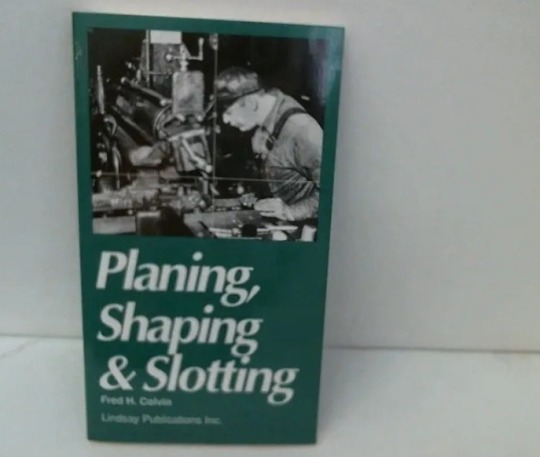
After doing some light digging I found something out:
This book does not exist. Meaning, it was made specifically for ST S5. I went down a bit of a rabbit hole trying to break down everything about this book that we can see to potentially find out its importance. The Photo: - Doing a reverse image search of the factory worker didn’t garner any results, which means this is either a photo that someone had of some random factory worker that has never been published previously or, they took this photo specifically for this book cover. A lot of work for something that is meant to be a throw away background prop.
Also when doing a quick reverse image search, it brought up similar photos (not this exact one though) of factory workers. Specifically factory workers working on manufacturing tanks and turrets.
“Planing, Shaping & Slotting”
A quick google search of those terms reveals that these are all different mechanical operating processes. Most specifically used in woodworking and metal working. The major difference seems to be a difference in how the machine cuts the wood/metal.
Fred H Calvin
Looking up this name as an author yields no results. HOWEVER, something I do find interesting is if you just Google “Fred H Calvin”, this is the first result:
Calvin’s doctrine of predestination is a book by Fred H Klooster, who is a former professor of systematic theology at Calvin Seminary, specializing in the study of John Calvin. - John Calvin is a well known French theologist who is known for his doctrine of predestination and the birth of Calvinism.
Calvinism, also called Reformed Christianity, is a major branch of Protestantism that follows the theological tradition and forms of Christian practice set down by John Calvin and various other Reformation-era theologians. It emphasizes the sovereignty of God and the authority of the Bible
Predestination by definition, at least in theology, is the doctrine that all events are willed by God, usually with reference to the eventual fate of the individual soul.
- If you look at the reviews on the book, there is really only one that kind of breaks down the main points of the book, which I find to be very interesting:
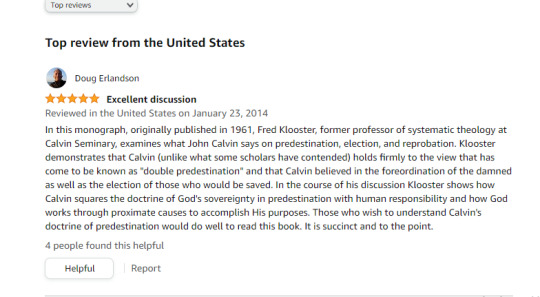
Now, I am by no means an expert in theology so I had to go and breakdown what some of the key terms used here mean in reference to theology and Calvinism specifically:
**important note** all of these definitions are pulled directly from Google, so I don’t know if these are all 100% accurate or if anything is being misrepresented.
Election: In Christianity, particularly within the theological framework of Calvinism, election involves God choosing a particular person or group of people to a particular task or relationship, especially eternal life. Election to eternal life is viewed by some as conditional on a person's faith, and by others as unconditional. Unconditional election (also called sovereign election[1] or unconditional grace) is a Calvinist doctrine relating to predestination that describes the actions and motives of God prior to his creation of the world, when he predestined some people to receive salvation, the elect, and the rest he left to continue in their sins and receive the just punishment, eternal damnation, for their transgressions of God's law as outlined in the Old and New Testaments of the Bible.
Reprobation: Reprobation is God's eternal decree whereby he foreordained that (1) certain persons would be excluded from the number of those saved by grace, and that (2) those same persons would instead experience his just wrath. - Something of note that I also found about reprobation, at least in Calvinism, is that God is not viewed as the author or creator of sin, but rather it’s “fearful, irreproachable, just judge and avenger.”
Double predestination: Double predestination is the idea that not only does God choose some to be saved, he also creates some people who will be damned. Some modern Calvinists respond to the ethical dilemma of double predestination by explaining that God's active predestination is only for the elect.
Foreordination: Definitions of foreordination. (theology) being determined in advance; especially the doctrine (usually associated with Calvin) that God has foreordained every event throughout eternity (including the final salvation of mankind)
Unlike predestination, foreordination allows for individual agency (the ability to choose whether to fulfill one's callings).
Proximate: So looking up proximate in relation to theology I found what is called the proximate cause doctrine. The proximate cause, also called legal cause, refers to a primary cause or an incident that set everything in motion.
So from my rudimentary understanding Calvin believed, in relation to the end of the world, that God has predetermined who will be saved and who will be damned since the creation of the universe. That he has chosen, or elected, certain people to have a specific role in the salvation of mankind and that they, as well as the damned, have the ability, or foreordination, to choose whether they want to fulfill that calling. And that all of this will be set into motion, or proximated, by a specific incident or event.
Lindsay Publications Inc.
Doing some digging, I did find out that this is a real publication company. If you look at a list of their published works, you see that they are mostly specialized in manufacturing and machine building books. A lot of their works were published in the mid-to-late 80s and early 90s.
Now taking everything we’ve learned, I’m sure we are all wondering: How does this relate to Stranger Things?
So based on a couple of theories that are already floating around about S5, especially because of the inspo board the writers posted, I believe this book could be alluding to the party working on building some form of machine, potentially in one dealing with time travel. Let me explain:
So we are all already under the idea that s5 is going to deal with time in some form or another, whether that has to do with time loops, time travel, or something similar. We also know that the Upside Down is stuck on the day that Will was taken into the Upside Down and that s5 potentially opens with a flashback to Will in the Upside Down.

Also based on those weird AI generated clips the writers shared during the strikes about specific scenes in s5 we can tell that Jonathan and Steve are building something as well as Dustin, Nancy, and Jonathan in some kind of machine(car?) traveling through some kind of hellscape.




Based on things they have already referenced in Stranger Things, I wouldn’t be surprised if they took inspiration from Back to The Future and tried to make their own version of the DeLorean. The book, just as a manual on machinery, could be used as a guide on how to build said machine. Especially since none of the party, except for maybe Dustin,has any understanding on building something of that magnitude.
That part seems obvious based on things we already know. All we are left with is the question of why they are building this machine in the first place. I think the answer could potentially be explained in the other clues of the book. Stranger Things has dealt in religious imagery before, especially in s4. I found this reddit post specifically talking about all the religious symbolism we see in s4.
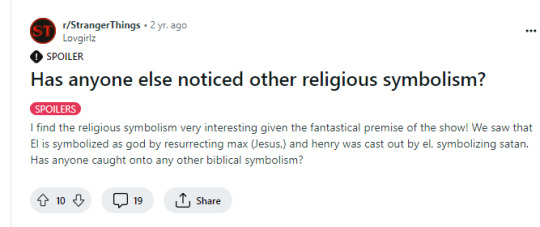
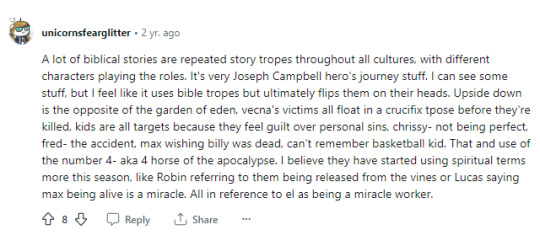
Since they have dabbled in religious imagery before, it wouldn’t be a stretch to assume that they will continue that theme in s5. In regards to Calvinism specifically, we can take a look again at my rudimentary explanation of Calvinism: So from my rudimentary understanding Calvin believed, in relation to the end of the world, that God (Henry/One) has predetermined who will be saved and who will be damned(Vecna’s victims) since the creation of the universe (The Upside Down). That he has chosen, or elected, certain people (Eleven/Will(?)) to have a specific role in the salvation of mankind and that they, as well as the damned(The People of Hawkins), have the ability, or foreordination, to choose whether they want to fulfill that calling. And that all of this will be set into motion, or proximated, by a specific incident or event(The events of the finale of s4).
Them time traveling back in time to prevent the events of s4, or even Will being taken in the first place, could be them refusing the call of their roles in Henry’s version of the end of the world/Hawkins.
Something else interesting is that this book appears underneath the poster of Pink Floyd The Wall. There is a really good post (here) about what The Wall is about. It could be easy to assume that another thing that sets the events in motion could be that the party is not dealing well with coping with the trauma of s4. Eleven’s failure to save Max/Hawkins; Dustin’s failure to save Eddie; Mike dealing with his failed confession and crumbling relationship with El; Will dealing with his, supposed, unrequited feelings for Mike/the return of his connection to the UD; Lucas dealing with the loss of Max. We could see any individual member of the party building a wall around themselves after that. There could potentially be something that happens in early s5 that will cause one or more of those walls to crumble, and the way they see to rectify it is by building a time machine to save those they’ve lost. It also doesn’t hurt that the person in the poster easily looks like one of Henry’s victims.

I could be way off base here, but I just think all these little details are interesting to pay attention to. Especially since the Duffers have referenced that they hide things in the background purposefully to foreshadow things in the main story.
Tldr; Planing, Shaping & Slotting is foreshadowing the party building a time machine to save Max/prevent the end of the world.
#stranger things#st#st s5 theory#st s5 speculations#the duffers#eleven#max mayfield#dustin henderson#lucas sinclair#nancy wheeler#steve harrington#mike wheeler#will byers#jonathan byers
11 notes
·
View notes
Text
NaNoWriMo2023 Spells Day 03: Free Space
(Skipping "Tape" for now as I can't seem to find a spell that actually incorporates tape as a part of it, and not just as a quick adhesive)
@asksecularwitch
I'll just go ahead and link to what the author refers to as a "cyberspace book" that outlines an entire method of using a chessboard in all kinds of spells:
Magic for Squares by Tony Perez
To summarize the setup:
The chessboard is placed as a diamond, with the four corners pointing at the four cardinal directions (black tiles pointed at the north-south axis). The center four squares are the "starting point", where the pieces selected for the spell (or other relevant objects) are placed. On the corners are the unused chess pieces, still grouped according to their color (black occupying north and west), acting as Witnesses to the scene unfolding at the center.
The arrangement is then charged by placing items symbolic to the elements in their places along the four cardinal corners, and then vibrating their names. The book uses "Integra (N - earth), Renevator (E - air), Igne (S - fire), Natura (W - water)". The same can then be done to "reset" the board to a neutral state.
To use the magical chessboard, the relevant chess pieces and other props are placed at the central square of the board, and arranged in ways that reflect the spell's goals. The author provides several different arrangement ideas, such as elevating chess pieces, making figures face each other or away from each other, and even interacting with them as if they are the person they represent.
A chessboard is a very interesting choice of tool - the first thing it reminds me of is that characterization trope where a character is shown to be good at chess to signify that they're Smart(tm) and/or Manipulative(tm). Using a chessboard as the... setting? of a spell places the caster as the chess master of the situation, manipulating its pieces to suit their goals. As the author is a playwright, and has mentioned their experiences in stage-blocking as an inspiration for this method, playing chess master may not be far-off.
With the addition of the elements and cardinal points though, it seems that the chessboard is acting similarly to a specific kind of altar, or even a circle...? I don't think I have the vocabulary for this lol. It's not something I use, but I see whole rituals of setting up an altar and calling the four elements from the four cardinal points and leaving the ritual objects inside it a lot, and the way the chessboard utilizes the elements and the Witnesses give me the same impression.
I quite like the idea of using the center cross, the point where the two opposing sides meet, as the focal point. I think it's similar to the idea of using the crossroads or a liminal space as a location of power, to make changing the direction of things easier.
The charging and resetting of the chessboard is an interesting bit - the author uses an alternative meaning for INRI. As the Philippines is mainly Roman Catholic, it makes sense that magic practicioners here find power in Catholic Christian imagery and verses - the number 3, Catholic saints, and Catholic holidays feature a lot in local magic beliefs. Google tells me that the "igne natura renovatur integra" meaning allegedly came from the Rosicrucians, and translates to "by fire, nature renews itself". It's a very fitting phrase to use when you're changing the nature and function of a chessboard from a board game to a magical tool.
My Latin isn't Latin-ing well, so I don't have much of an opinion on the translation and the assignation of the words to the elements. I do know that assignment of cardinal directions to the elements varies by tradition, but not enough to know why the difference in what seems to be closely related / commonly syncretized traditions exists.
As for the chess pieces themselves, the author assigns the white pieces as Yang, and its King and Queen pieces as a 'protagonists' (the playwright influences coming in), while the black pieces are Yin, and its King and Queen are the 'antagonists'. Personally, this seems unnecessarily gendered (and perhaps has some unfortunate implications regarding the colors), but it seems the author works with a system that treats "male" and "female" objects differently .(I'm not quite sure why yang is the Default Protagonist here, though.) Following the yin-yang associations, the white pieces are also used to attract influences, while the black pieces repel them.
In general, while I am really interested in the basic idea of the spell method - and anything that can easily masquerade as mundane objects and actions are of great interest to me - the creator of the chessboard spell uses systems that I don't follow and don't fully understand yet. I like the idea of using the whole board as a 'stage' of sorts, of having the pieces to 'witness' my plans unfold (something something about it's not real until you have someone/something see it happen), and using the center of a chessboard as a magical focal point. But other than that, I would completely rework the method he presented, relying on how I personally perceive the concept of chess instead of his playwright's perspective and the whole elements and yin-yang system.
#nanowrimo2023spells#eclipse exclaims#ok the method was just really interesting and i wanted to post about it even tho i dont think i understand it that well
10 notes
·
View notes